Review MISS FURY
Miss Fury is a forgotten heroine of the Golden Age. She is remembered these days, ironically, for her tangential resemblance to what she is not.
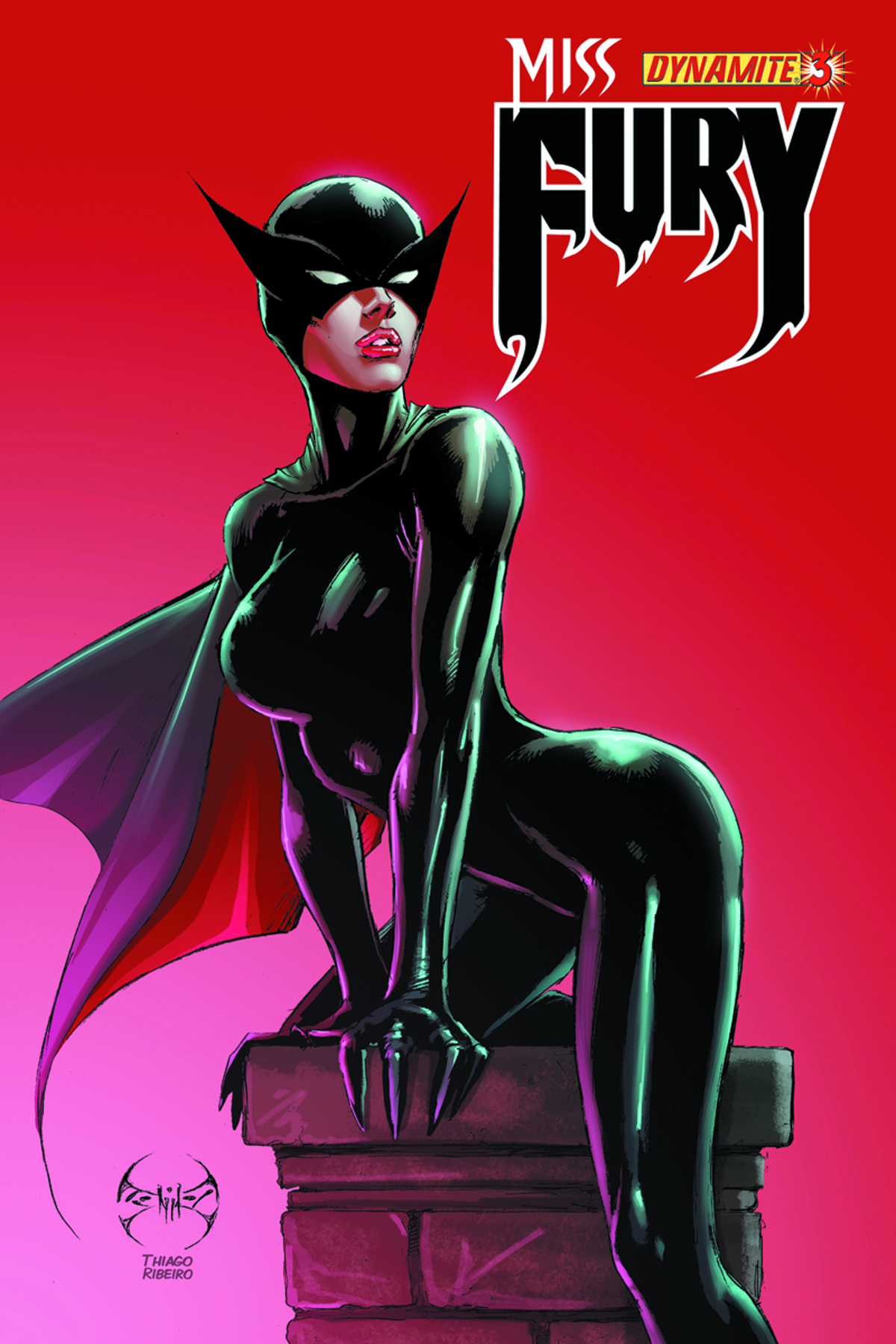
She first appeared as The Black Fury in April of 1941 as a Sunday comic strip by June Tarpé Mills, one of few women working in comics at the time, and it shows. There was a contemporaneous comic about a dark-coated stallion named Black Fury, so she, and her strip, was retitled Miss Fury in November 1941, and later gathered into comic book form.
Black Fury is remembered as the first a crime-fighting superheroine, dressed in a skintight black catsuit, complete with cat ears and claws, predating DC’s comics iconic Catwoman and Marvel’s clone Black Cat.
One article about Miss Fury (read in preparation for this column) asserted that the black leopard catsuit, worn for crimefighting, had the supernatural voodoo ability to bestow increased strength and speed on the wearer.
All this is untrue, or, at least, highly doubtful.
Miss Fury is not a superheroine. She is not Catwoman.
It is true that Tarpé Mills was one of the first, perhaps the first woman to pen and illustration a nationally syndicated comic. She allegedly left aside her first name, June, so as to not deter boys from reading a comic book written by a girl.
If so, I can only say such boys must have been young indeed not to see how feminine the writing style, the characters, and plot-weaving were. This is a very girlish story about a very girlish girl.
That she is willing to claw and scratch like a hellcat when menaced by men, or slap women and pull hair, is not, itself, an unfeminine trait: it merely means she is a feisty woman of fiery temper, or, in other worlds, a Miss Fury.
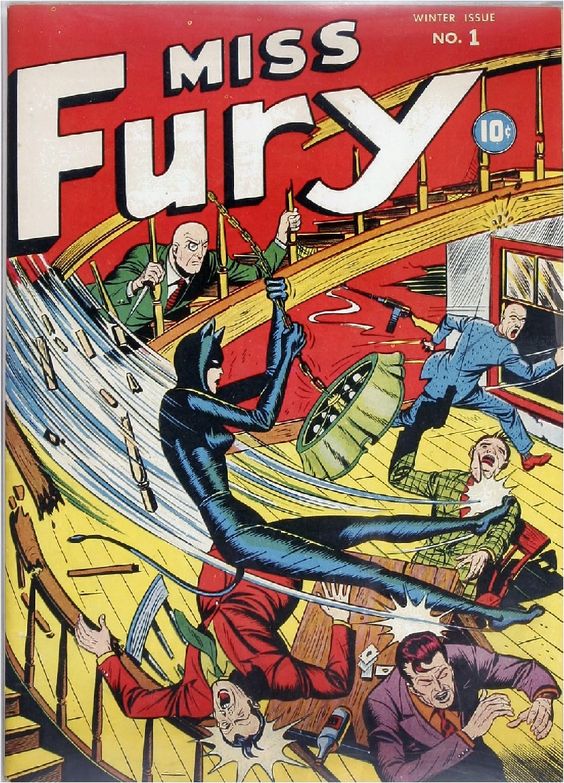
Miss Fury has no special powers nor particular fighting skill, nor does she don her black leopard skin to be her uniform as a crimefightress nor catburglar. She is neither. She dons the skin to hide her identity four times or less in some four hundred pages of comic panels, eight issues when gathered as comic books.
And Miss Fury is the heroine only in that she is the protagonist character: she appears only as one among an ensemble cast, and is often not involved in the action, or is not in the center of the action when she is.
So if she is not a superheroine nor a heroine, what is she?
Miss Fury is young and glamorous and wealthy socialite Marla Drake, who has nothing to wear to a costume ball, for she tore her last costume to bits in anger, when she learned another girl would be dressed the same.
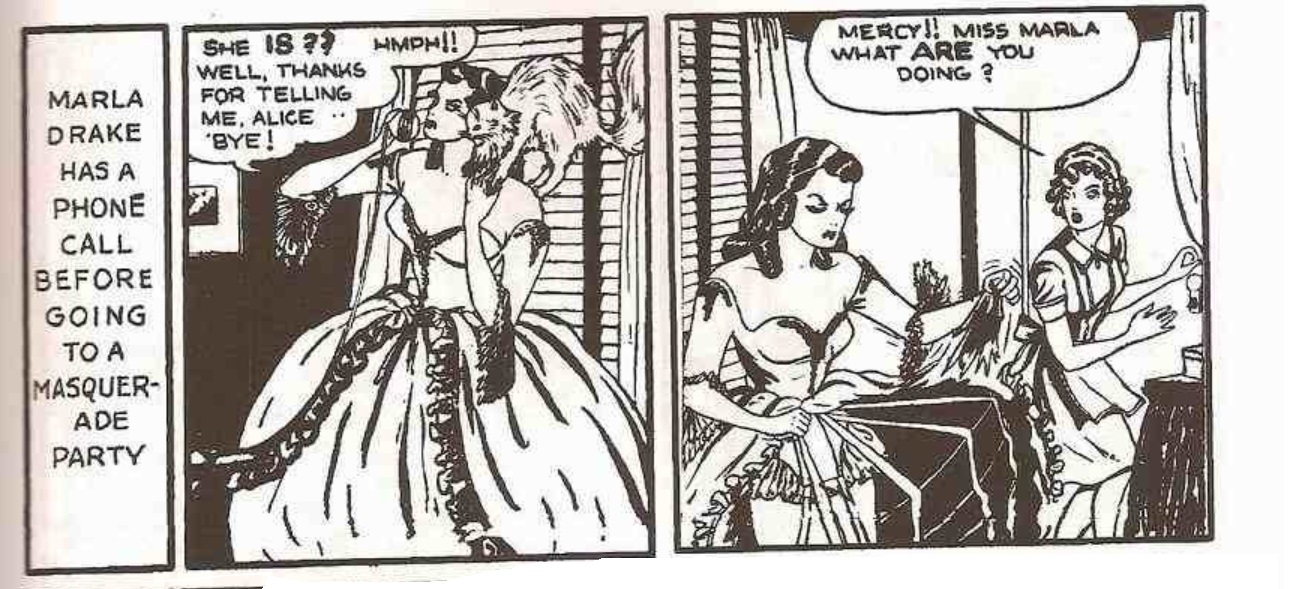
This is in the first panel of the first issue, and already we are in an area male psychology cannot reach — no women need be told how mortifying it is to be seen in duplicate dress. Men do.
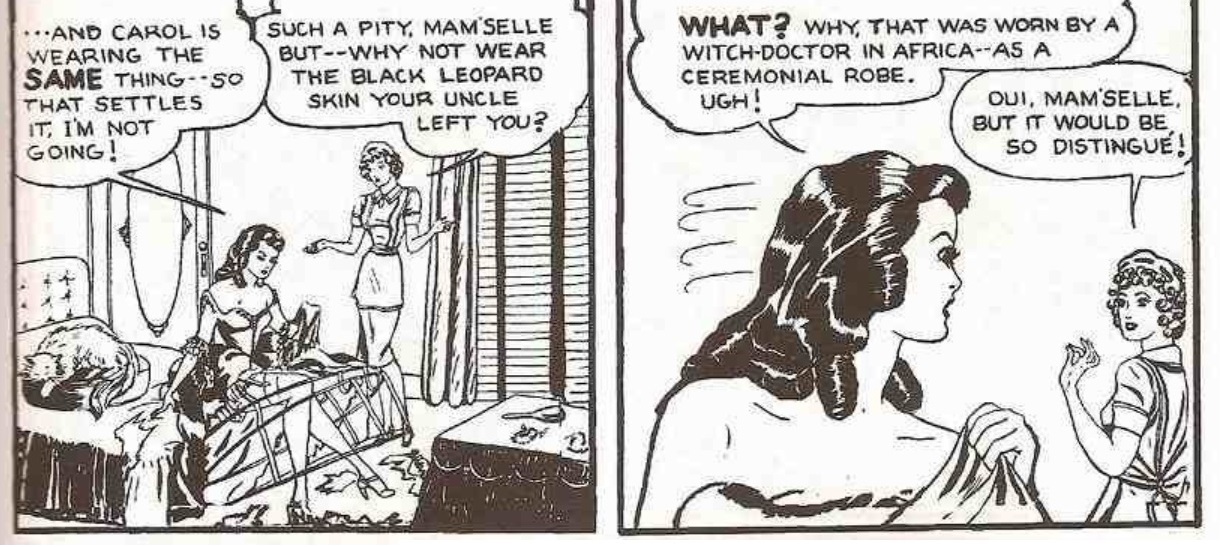
Marla is urged by her saucy French parlor maid, Francine, to wear the black leopard skin left by Marla’s uncle. Marla at first scoffs, saying that it was worn by an African witch-doctor as a ceremonial robe. Ugh!
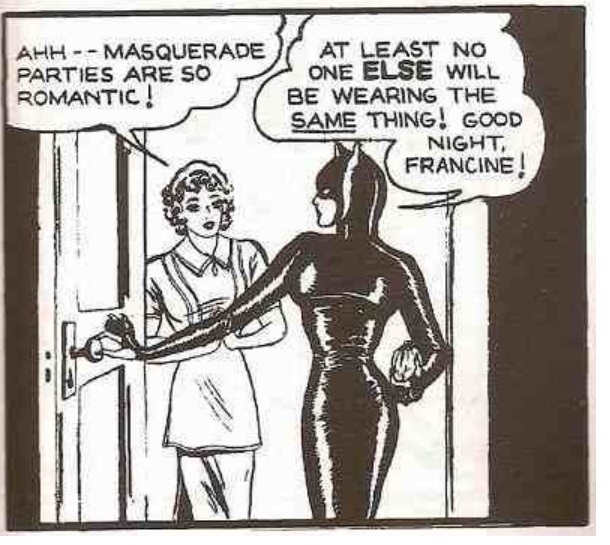
But in the next panel, she is dressed in the leopard girl suit, complete with mask, ears, tail, and clawed gloves, to drives to the party in her motorcar.
Taking a shortcut on a lonely back road, she is abducted at gunpoint twice, once by a detective, once by a crook he seeks, and manages by mischance to clonk both unconscious, and leaving the two handcuffed together, so that cop can nab crook when both awaken, and take the credit. The gossip column in the paper the next day dubs her Black Fury.
That is it. That is the origin story.
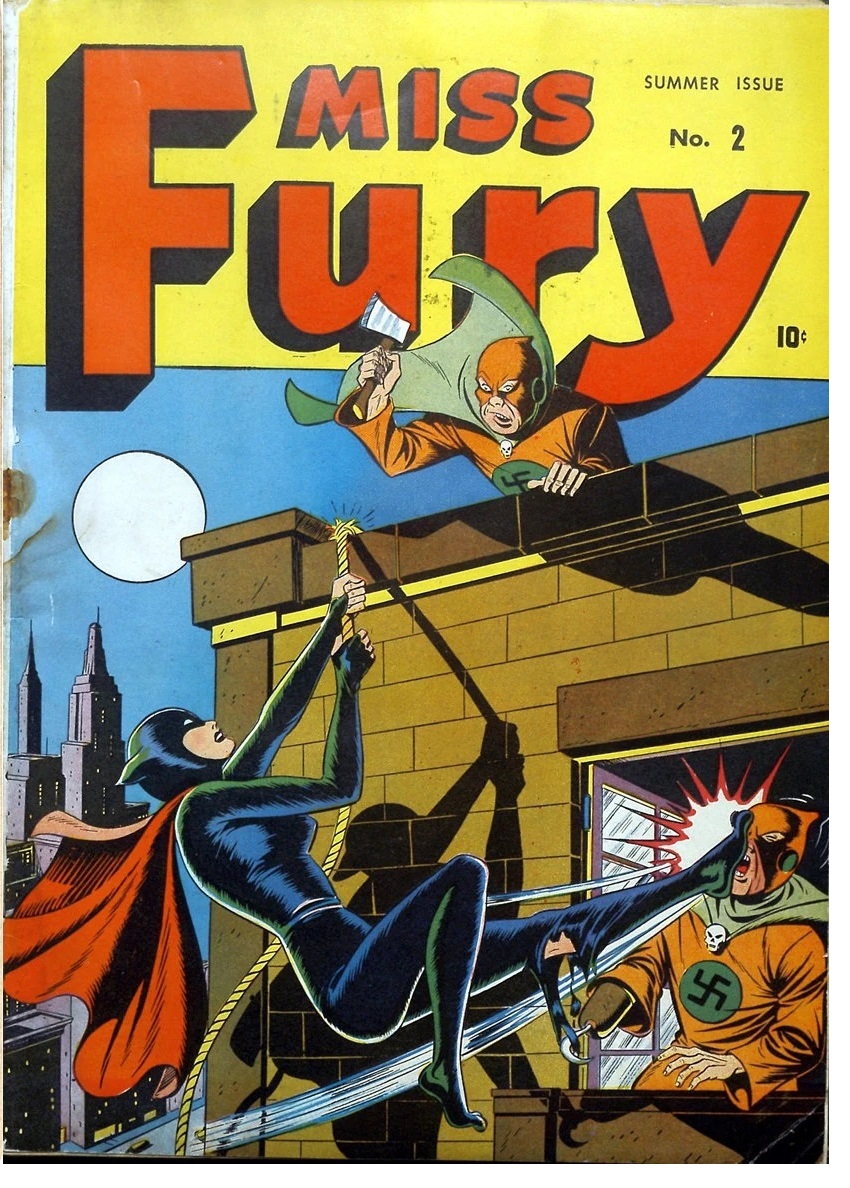
Nowhere is there any hint that the black leopard skin robe bestows special powers on wearer. However, in a later episode, much later, Marla recalls the uncle claims the robe was blessed: it allows the wearer to accomplish any mission he undertakes. Miss Marla concludes that the skin is also accursed, for she notes dire personal misfortune follows every time she has ever worn it.
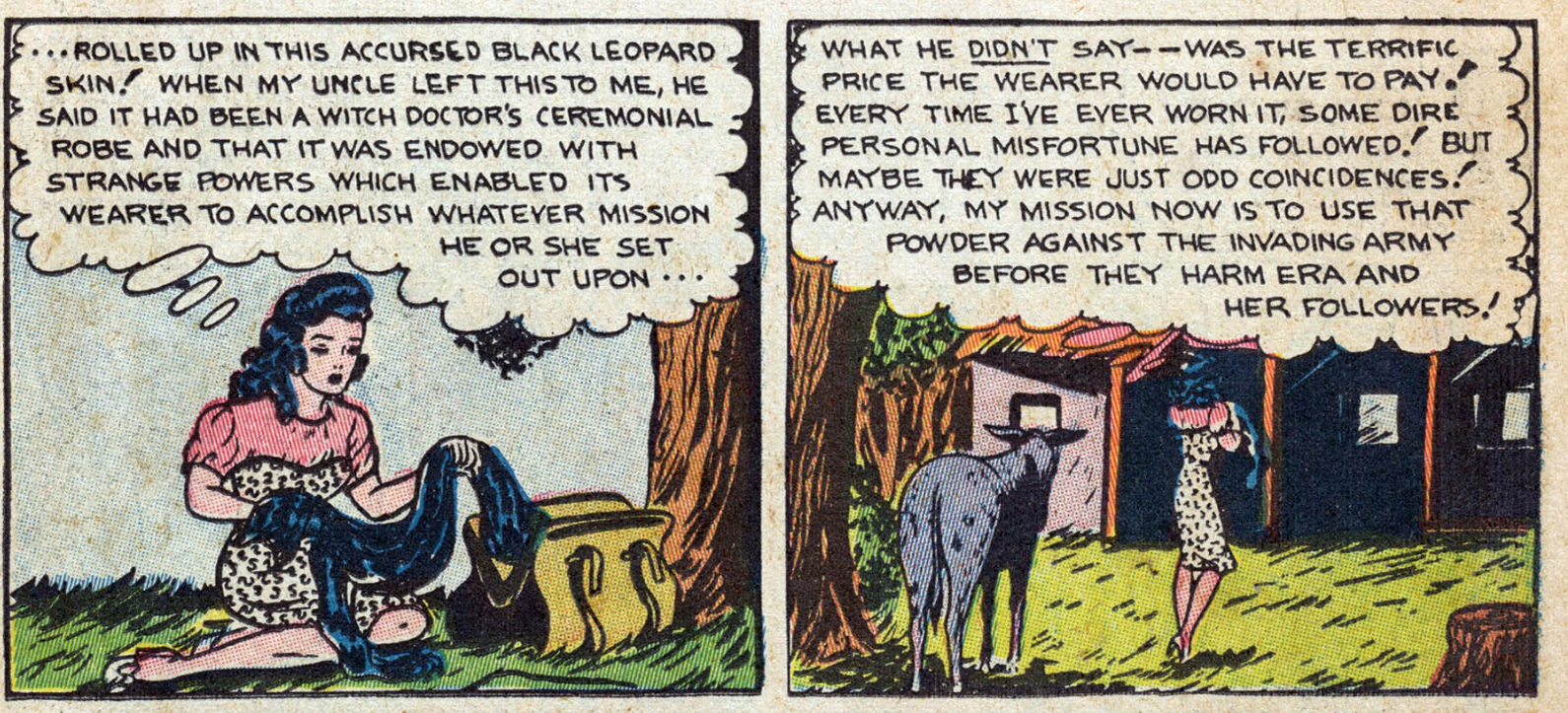
Not long after, An albino Brazilian Indian intones, “Anyone who ever used the strange powers of that black leopard skin has paid dearly for it — many with their lives!” but there is nothing seen in the story whatsoever to imply that it has any powers, strange or otherwise.
On the other hand, after confirming that the leopard-skin robe is indeed cursed, the albino then says the curse will not afflict Miss Marla, because she never uses the robe for personal gain.
On the third hand, like many elements in this story, nothing comes of this remark one way or the other.
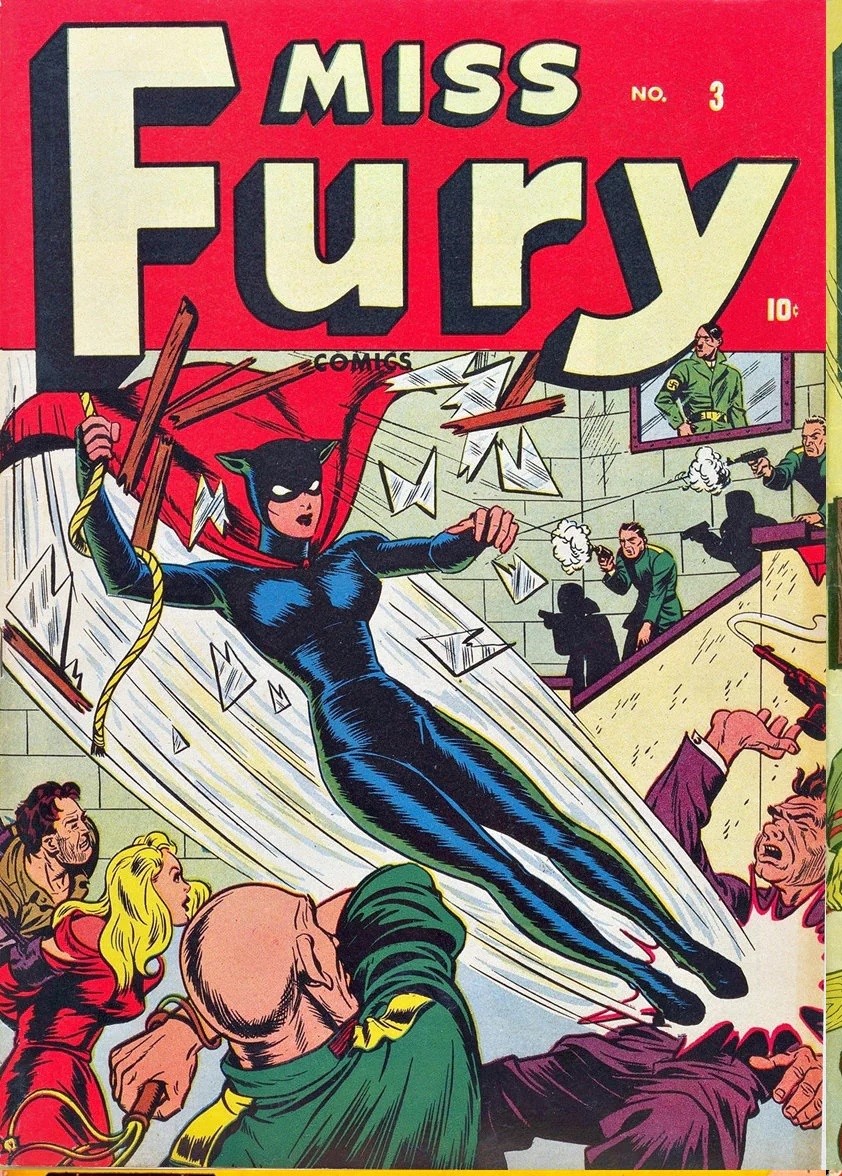
The comic book covers, each of them, misleadingly, show Miss Fury suited up in all her lithe curvaceousness in her skintight black-leopard catsuit, swinging into deadly action while dodging with machinegun fire, wide red cape flapping, kicking Japs, Nazis, or gangsters with her stocking feet. No such scenes, and nothing remotely like this, ever appears between the covers, rest assured. And there is no red cape.
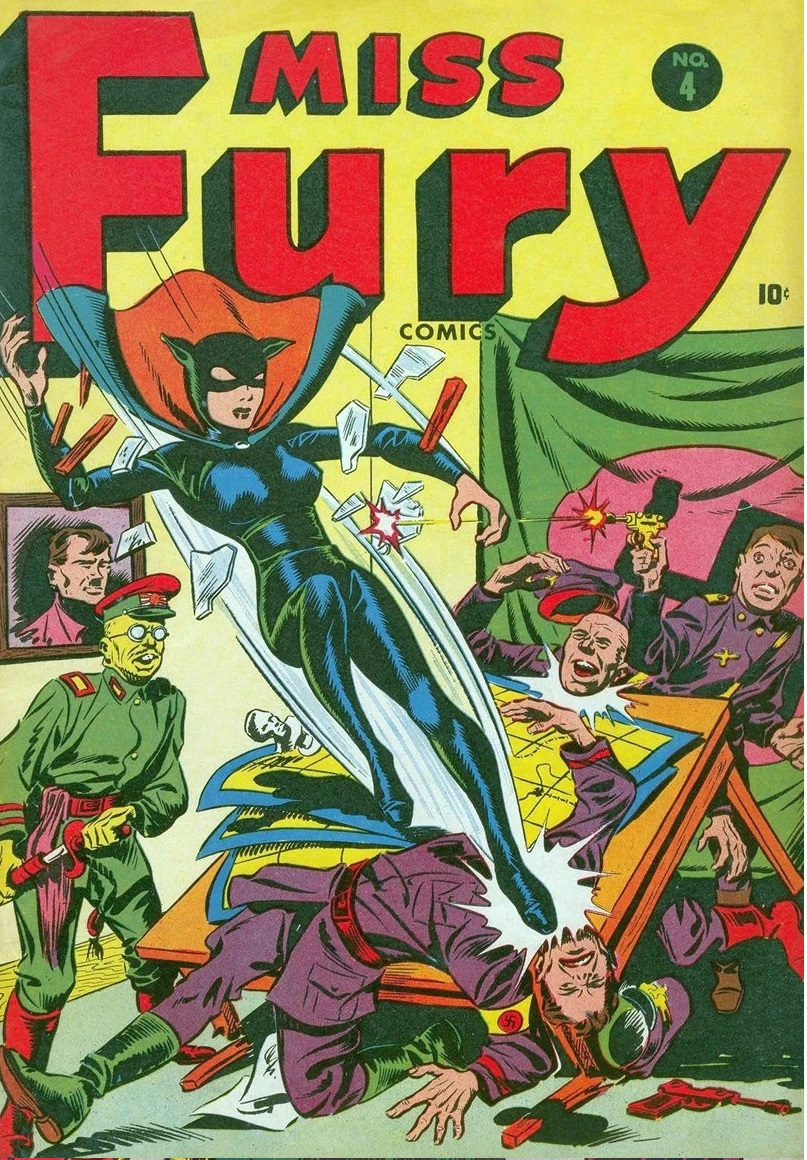
In any case, Miss Fury is not a crimefighter nor a Nazi-fighter. She fights only as much or little as feisty debutant might do, and then only when cornered: as mentioned above, in the opening scene, she claws a gunman grabbing her, knocks he gun from his hand with her tail, and when he steps on her hand to prevent her picking it up, in retaliation, she kicks him. There may or may not be leopard claws on the stocking toes: the pictures are inconsistent between panels.
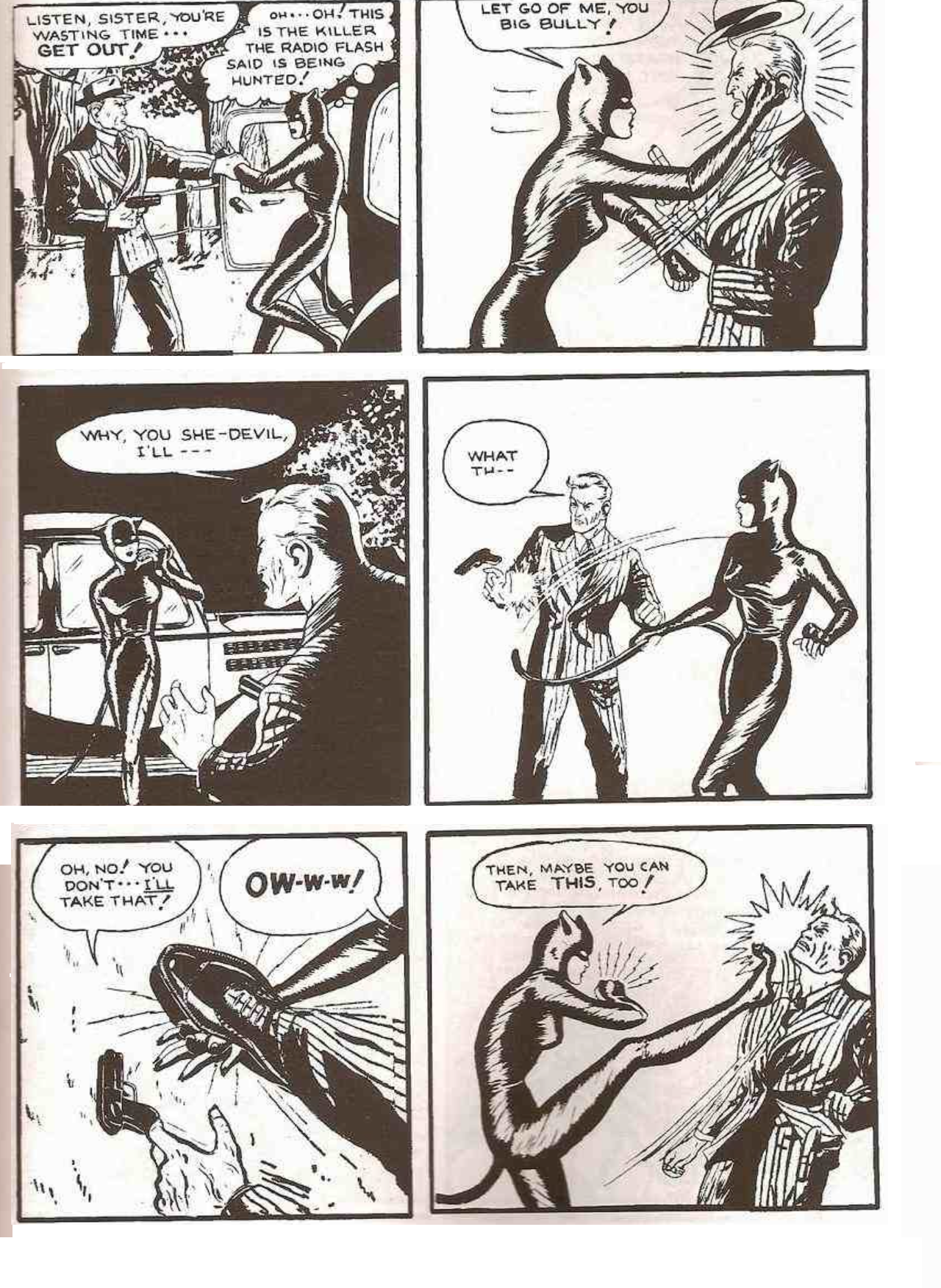
He bumps his head on the fender as he falls and is knocked out. This is not shown, as many crucial events are not shown, merely mentioned in passing in the dialog. That is the whole fight.
After this, Miss Fury dons the black leopard-skin a second time, to break into a house to recover blackmail letters. During this escapade, she claws a man grabbing her. The fellow is startled and releases her, and he draws a pistol, but is shot to death by an icy-blonde Nazi spy babe for some entirely unrelated reason.
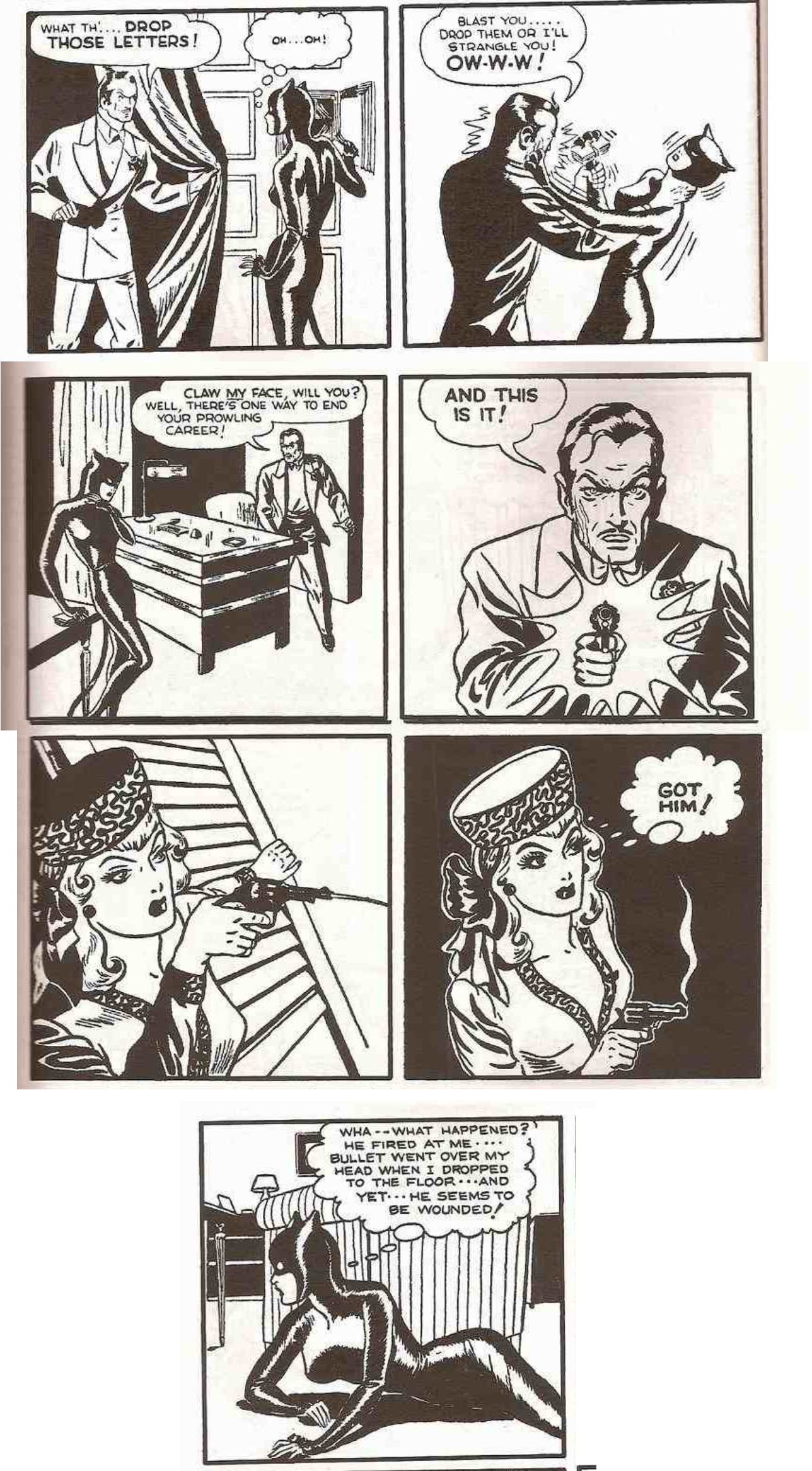
Later, while trying to sneak back to her penthouse, Miss Fury gets a flat tire, and must walk through back alleys in costume. She stumbles into a man who tries to grab her.

Again, she claws the fellow and this man is startled also and releases her. But he draws no pistol, so she slips away. After that, is the exciting adventure of her sneaking past her doorman.
She does don the black-leopard suit a third time, in order to ambush the murderess impersonating her, whom she jumps. This murderess turns out to be a murderer, who, yet again, grabs her, gets clawed in the face, is startled, and releases her. She flees the knife-wielding killer, tries to hide in the bathroom, slips, hits her head, and as she is unconscious in the bathtub, the killer turns the tap, leaving her to drown.
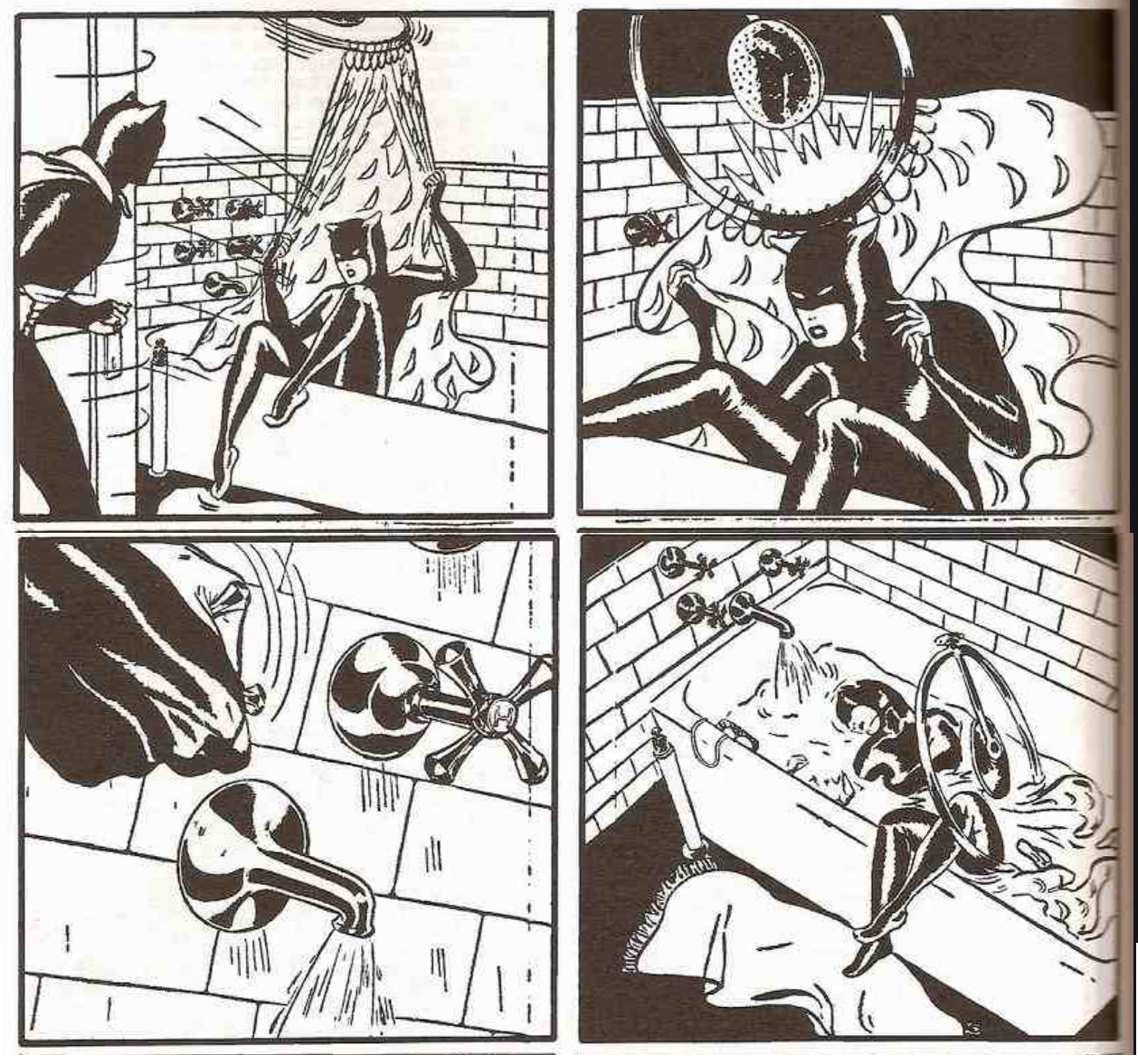
That is the sum total of the hand-to-hand combat involving Miss Fury in the whole run of eight issues, aside from catfights.
In none of these scenes does she do anything an angry girl of modest size and girlish strength could not do with a dinner fork, namely, tear a man’s cheek, except, of course, for knocking a gun from a gunman’s hand with a tail. That may have been an act of supernatural voodoo power.
Miss Fury also fights girls. There is a lurid hair-pulling catfight in a bedroom between her and the shapely hot-blooded Latina hottie, Era the insurgent-queen of Brazil. While the building is afire.
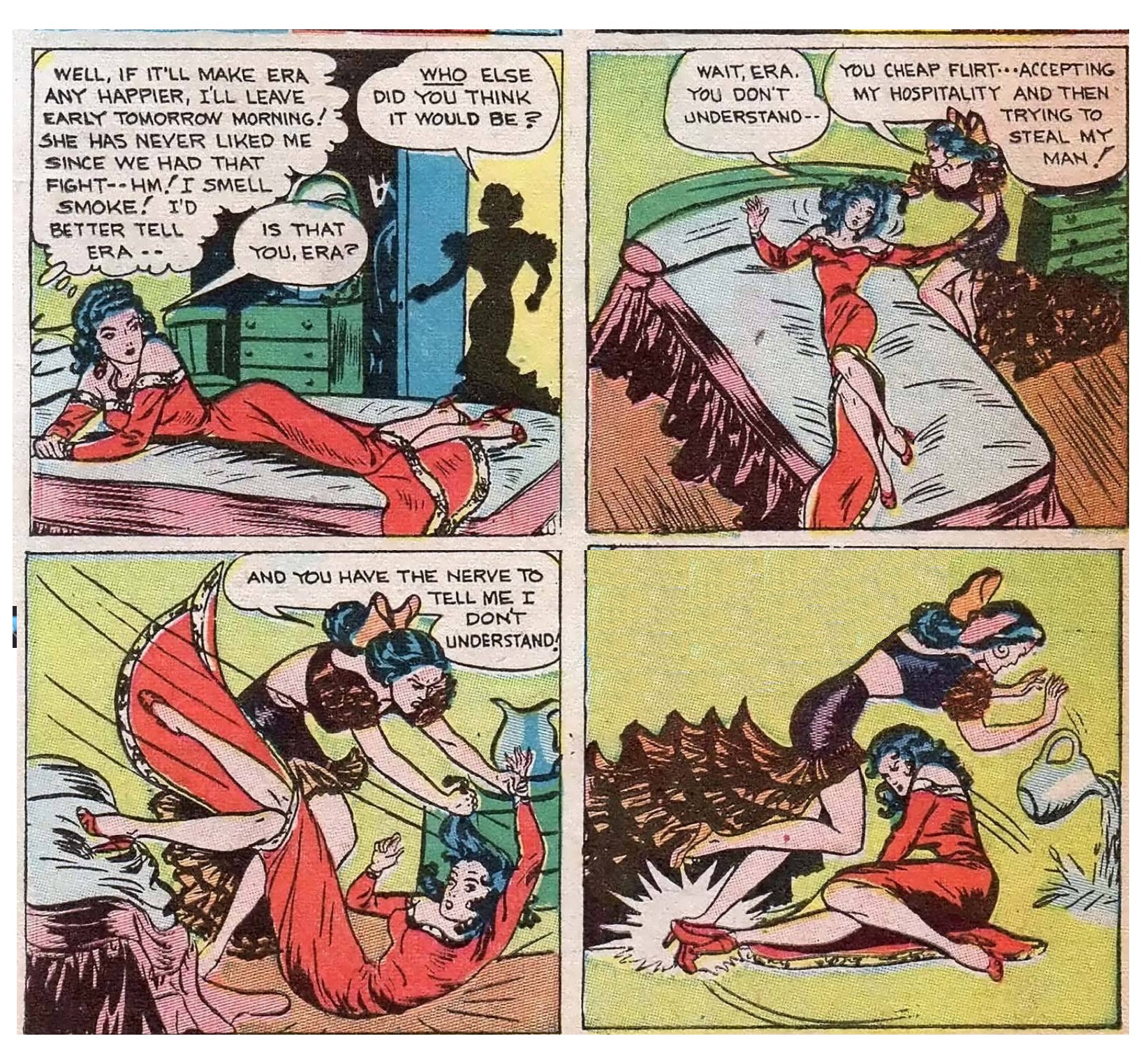
And there is also a catfight with the shapely icy blonde but wicked Nazi babe, Baroness Erica, who surprises Miss Fury, who has stripped off her catsuit and hidden it in a potted plant, now in her underwear trying to steal a dress, which, obviously the Baroness has not put on yet, and so the two wrestle around the bedroom in their lingerie.
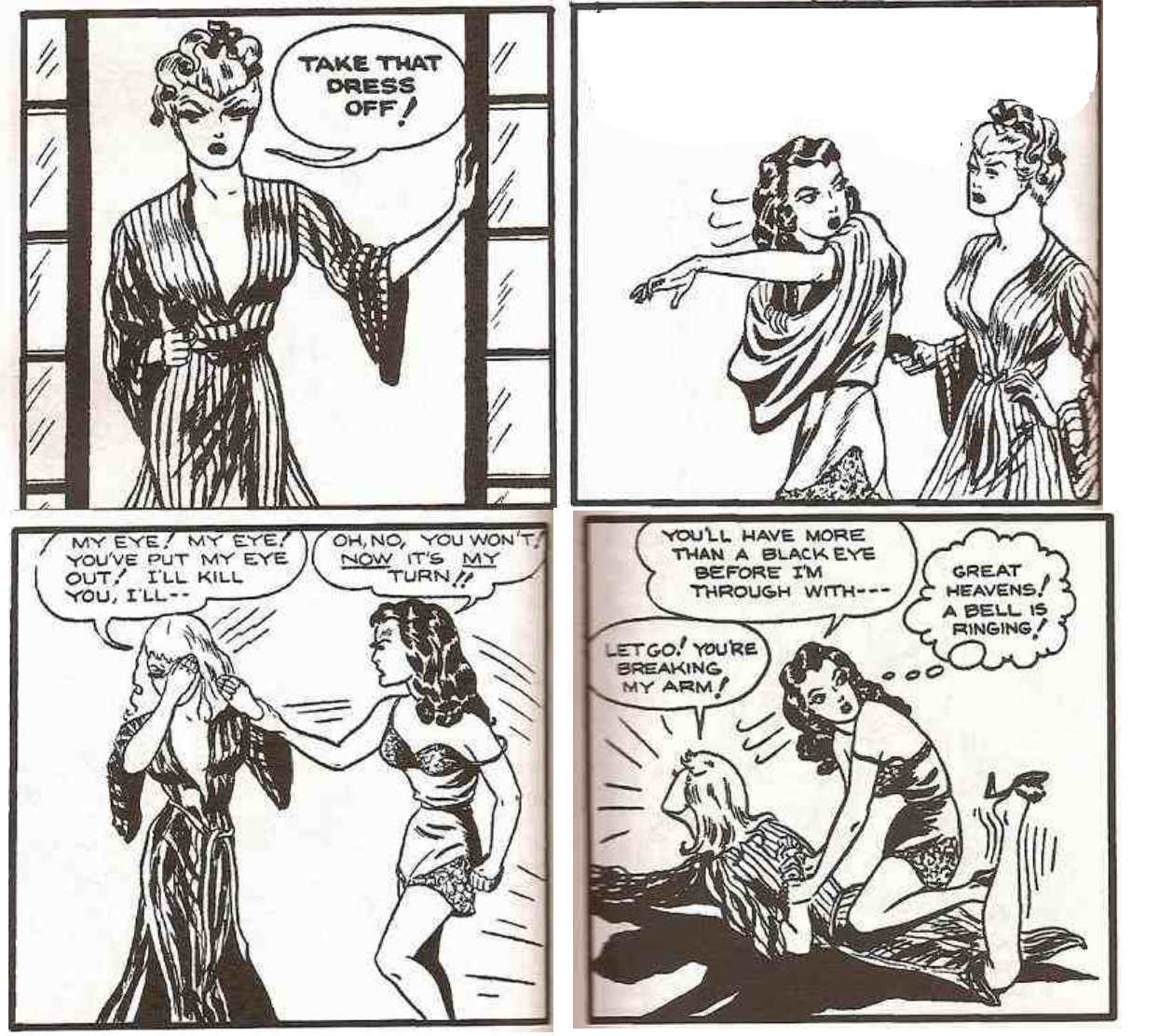
This is hardly Wonder Woman levels of prowess, or Batgirl. It is more on par with Nancy Drew, if Nancy owned a pair of opera gloves tipped with leopard claws.
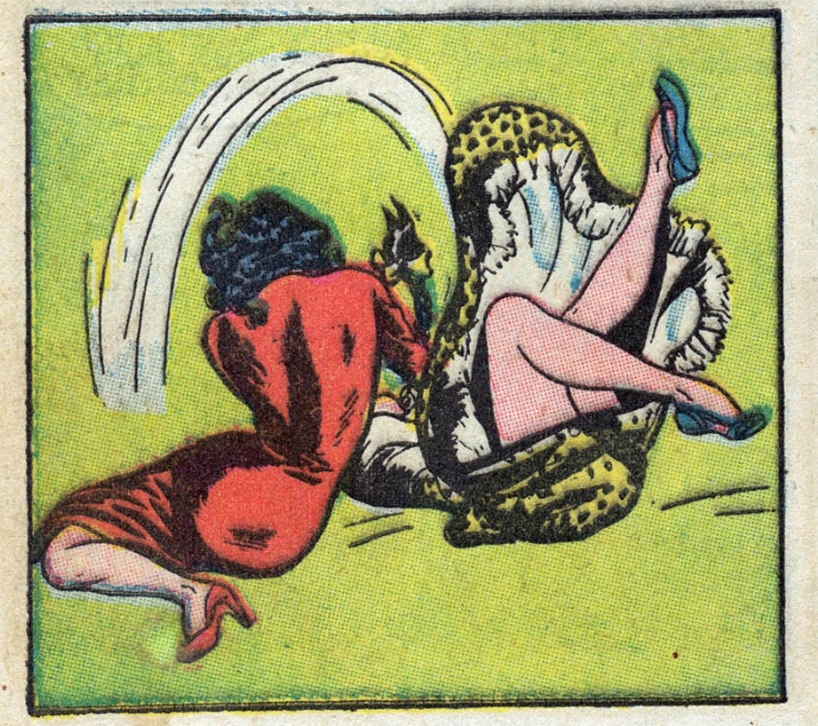
Or, to be a little more accurate, the whole is on par with the lurid covers of a typical pulp adventure story of the era, with a Flash Gordon level of love triangles between the various rivals and enemies flirting or mashing or making eyes or stealing kisses.
Perhaps surprisingly, perhaps not, there is a moderate amount of cheesecake in the tale.

Or, actually more than a moderate amount.
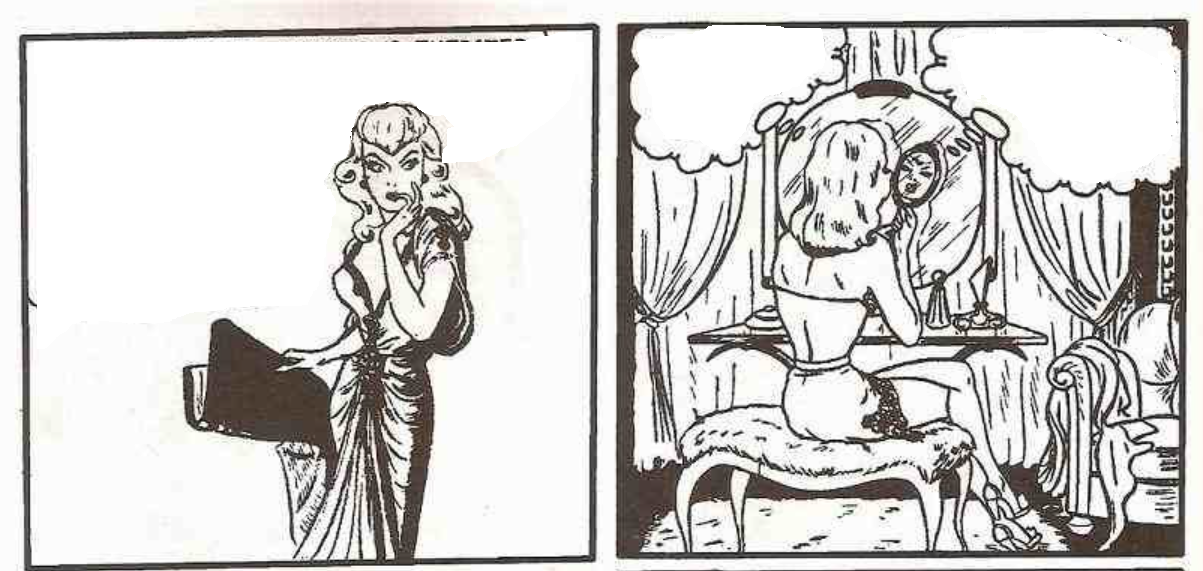
Tarpé Mills, the writer and illustrator, lingers over lovingly-drawn shots of long-legged beauties adjusting their stockings, donning or doffing reveling evening gowns, or seated at vanity tables in their lingerie.
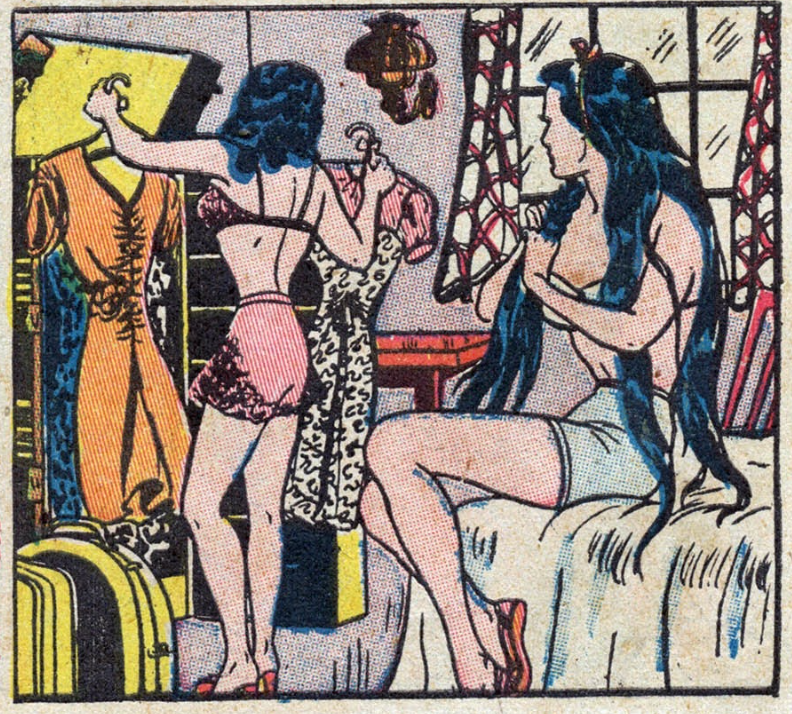
There are also paper dolls of the glamorous lady characters in their underthings, complete with cut out costumes to dress and undress them.

By the bye, it is Era, the hot-blooded Latina hottie, that dubs Marla Drake “Miss Fury.” This is not Marla’s crimefighter name, or a secret identity, or anything.
The two glamour dolls got involved in yet another a catfight when first they met because the handsome Don Chico, the Gaucho, flirts with both of them, and stole a kiss from one. Because Marla fought back with a temper as fierce as her own when Era clawed at her, Era dubbed her “Miss Fury.” That this is the name appearing on the cover seems to be a coincidence.
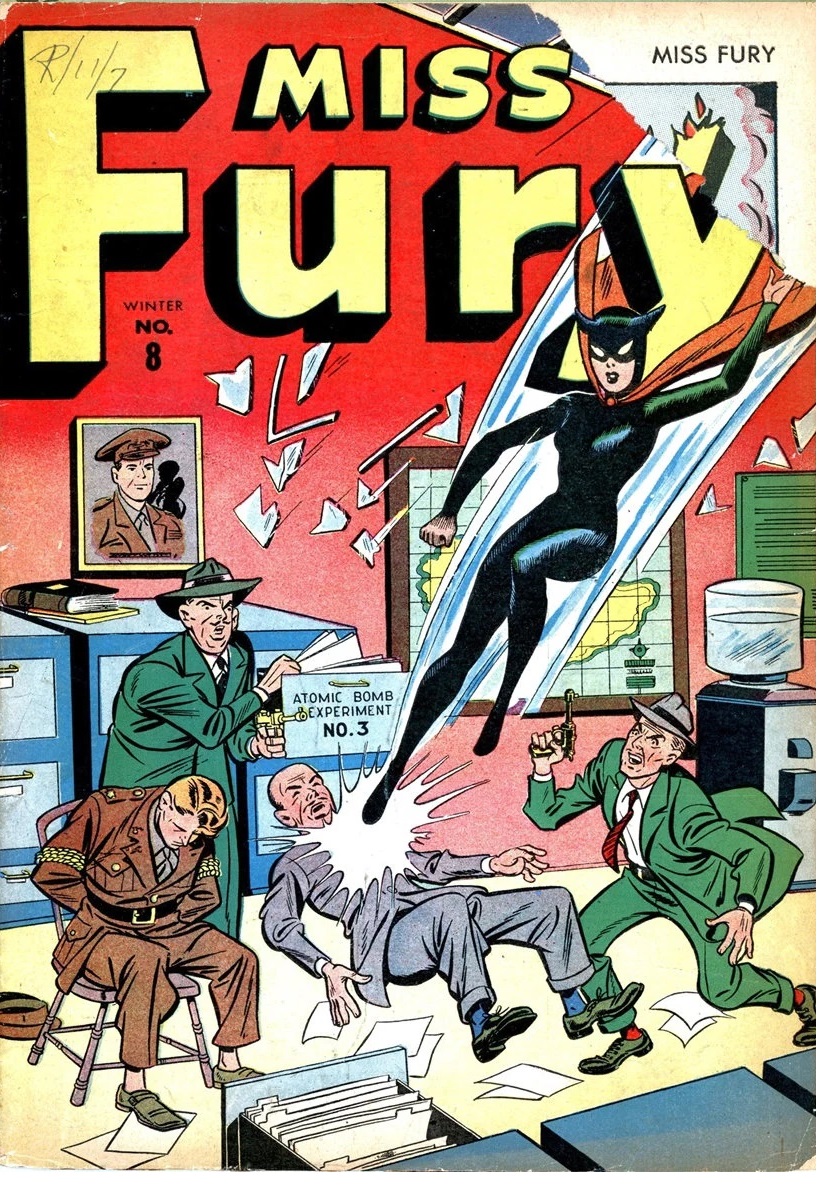
As said, Miss Fury is no Nazi fighter. But between her various overly-complex and slow-moving romantic misadventures, Miss Fury does indeed get involved in an overly-complex and slow-moving plot involving a Nazi attempt steal a superweapon for use to conquer Brazil.
This starts in America, with blackmail scheme, a murder of an eccentric scientist, and an attempt to frame Miss Fury by a muscular thug dressed up (rather unconvincingly) as the curvaceous and callipygous debutante.
There follows some rigmarole of her being sought by the police, then a whole issue recuperating from a rooftop fall, during which she does not appear, but during which she is abandoned by one fiancé, a toff, and gains another, a cop.
Thereafter, she flies to Brazil seeking her lost love, the toff, who meanwhile is being seduced by a scheming femme fatale, namely, mysterious icy blonde Nazi-babe Baroness Erica van Kampf. The baroness in turn who is in love with the brutal but bold Nazi Colonel (later, General) Bruno, a loyal German officer conspiring to overthrow and replace the Nazi high command. But Erica ensnared and menaced by her other lover, a handsome but hot-blooded Brazilian gangster named Manero, who is keeping the her prisoner in a swanky five-star hotel. The baroness plans to marry the toff in order to be granted permission to return to the United States.
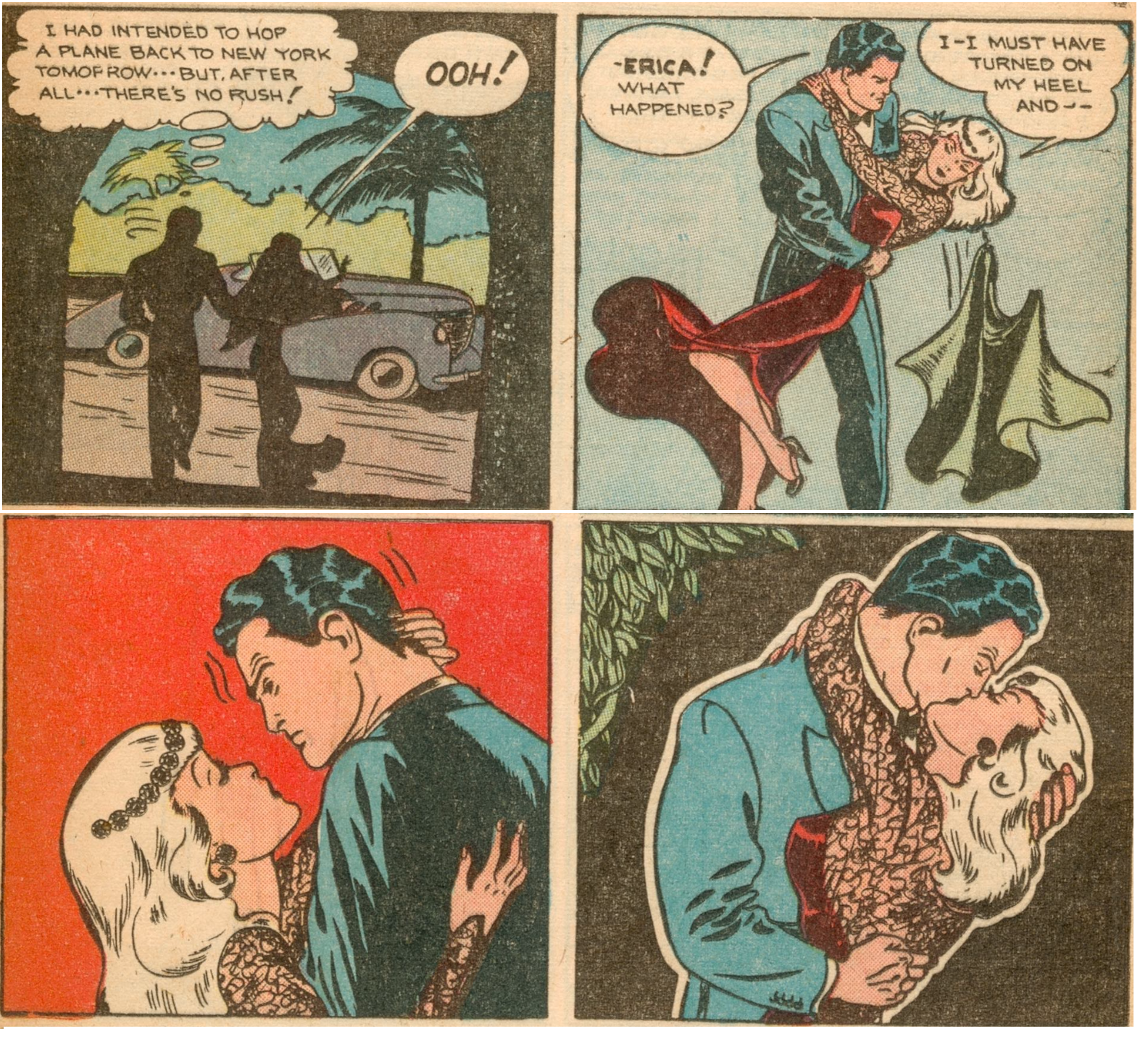
Meanwhile the detective who Miss Fury knocked out in scene one, Dan Carey, now secretly in love with her unsecret identity Miss Marla, has joined the military, and ends up stationed in Rio, just in time to mess up any hopes of reconciliation between Marla and her fiancé, who is found in the arms of a icy blonde.
Meanwhile, there is a war on. The Nazis planning to conquer Brazil are opposed by a ragtag band led the sultry and hot-blooded Era, her roughneck hill-fighters, the dashing and handsome Gaucho cowboy from neighboring Argentina, his impromptu cowboy calvary, a dashing English pilot dying from an unspecified disease, but eager to take to the skies one last time, and a comedy-relief pickpocket, braggart, and general tough-guy from the US of A named Fingers. An Oxford-educated albino Indian armed with blowgun, named Albino Jo, and his fierce native braves with their bowmen, join the fray.
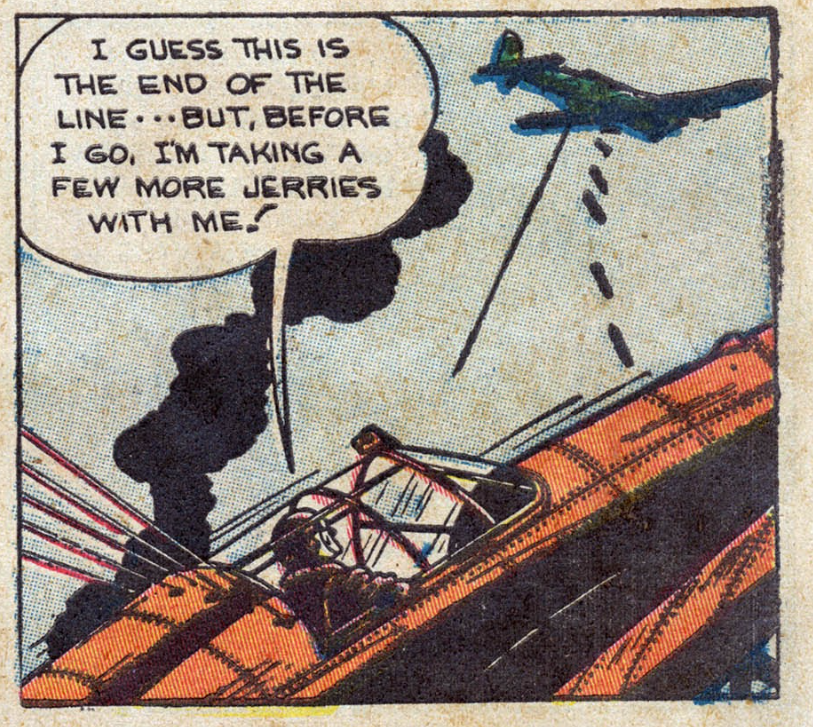
All of them are memorable and lively, in a one-note sort of way. Fingers was particularly charming, both for how remorselessly he cheats GI’s at dice, and for his eagerness to sock the Ratzi in the face.
In a battlescene when Fingers leads the partisans forth with fists and clubs, he says that it is bank night, and the Nazis are “owed some dividends.” At the time, and even now, he speaks for many.
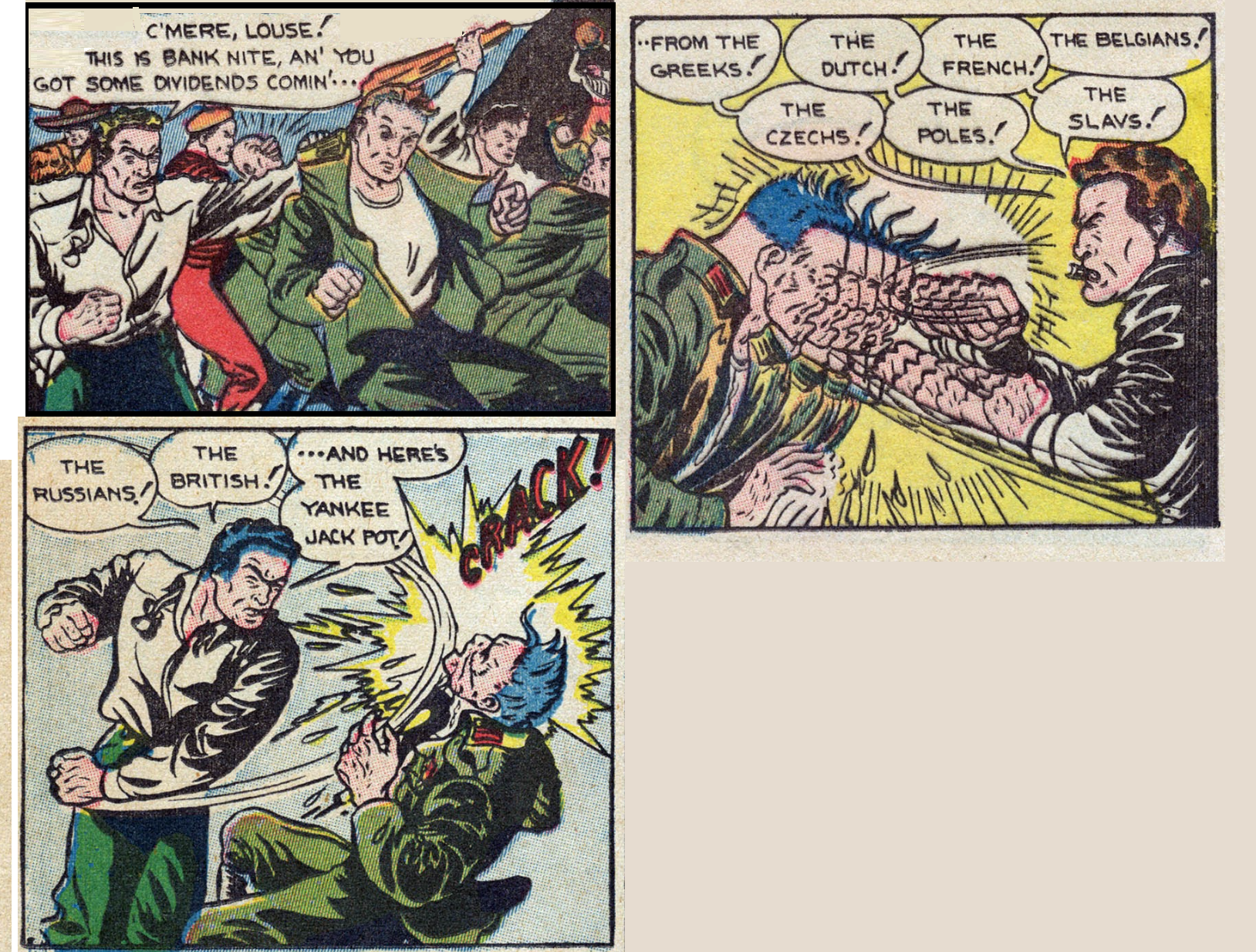
In all of this, Marla acts like a wealthy young socialite, not like a costumed adventurer. She is embroiled in these struggles and intrigues by mischance, has no real personal stake involved, and spend most of her time kidnapped, captured, or stranded, being menaced by brutally handsome villains, or being insulted by jealous rivals, or struggling with her luggage, of which, being a socialite, she has an abundance.
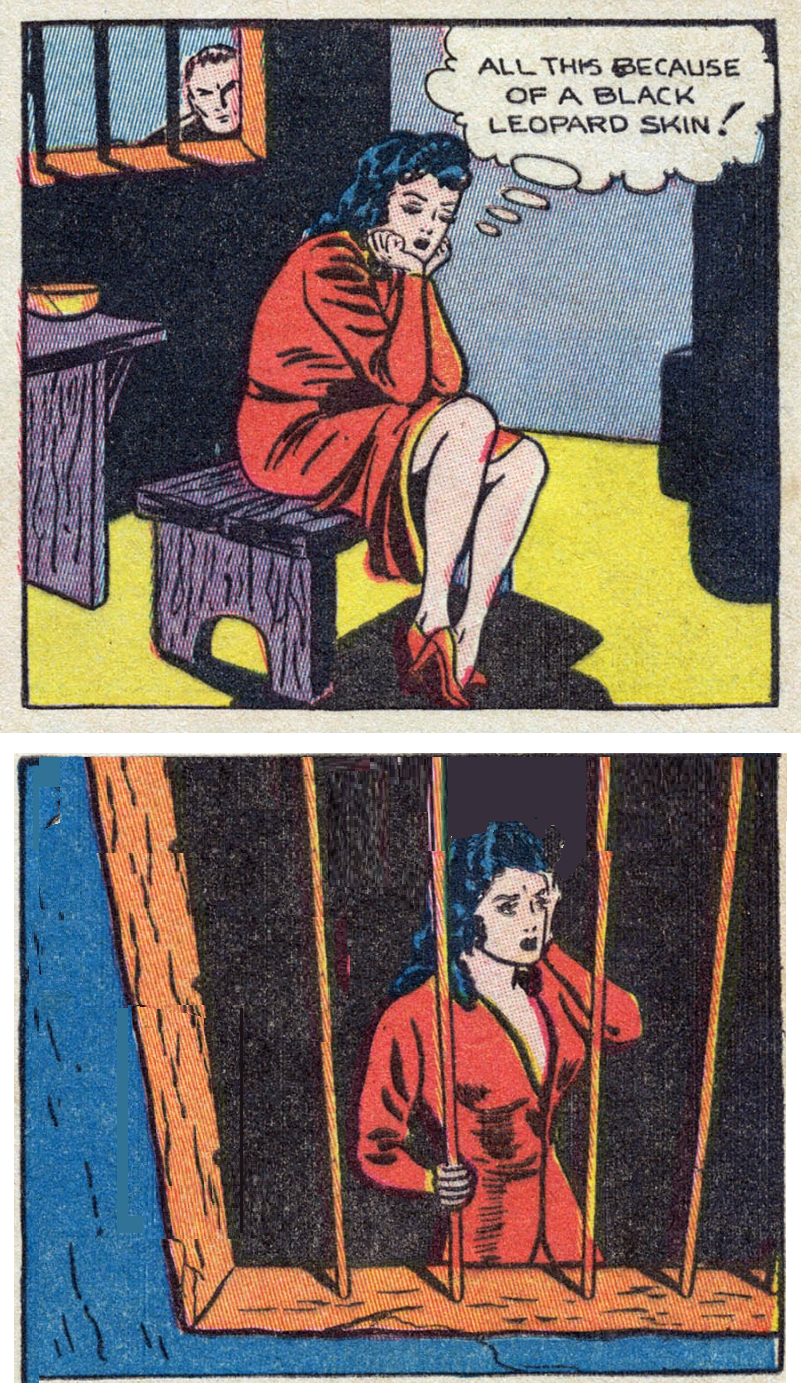
When she gets freed from one captor, usually she is captured by another, usually by mischance or mistake.
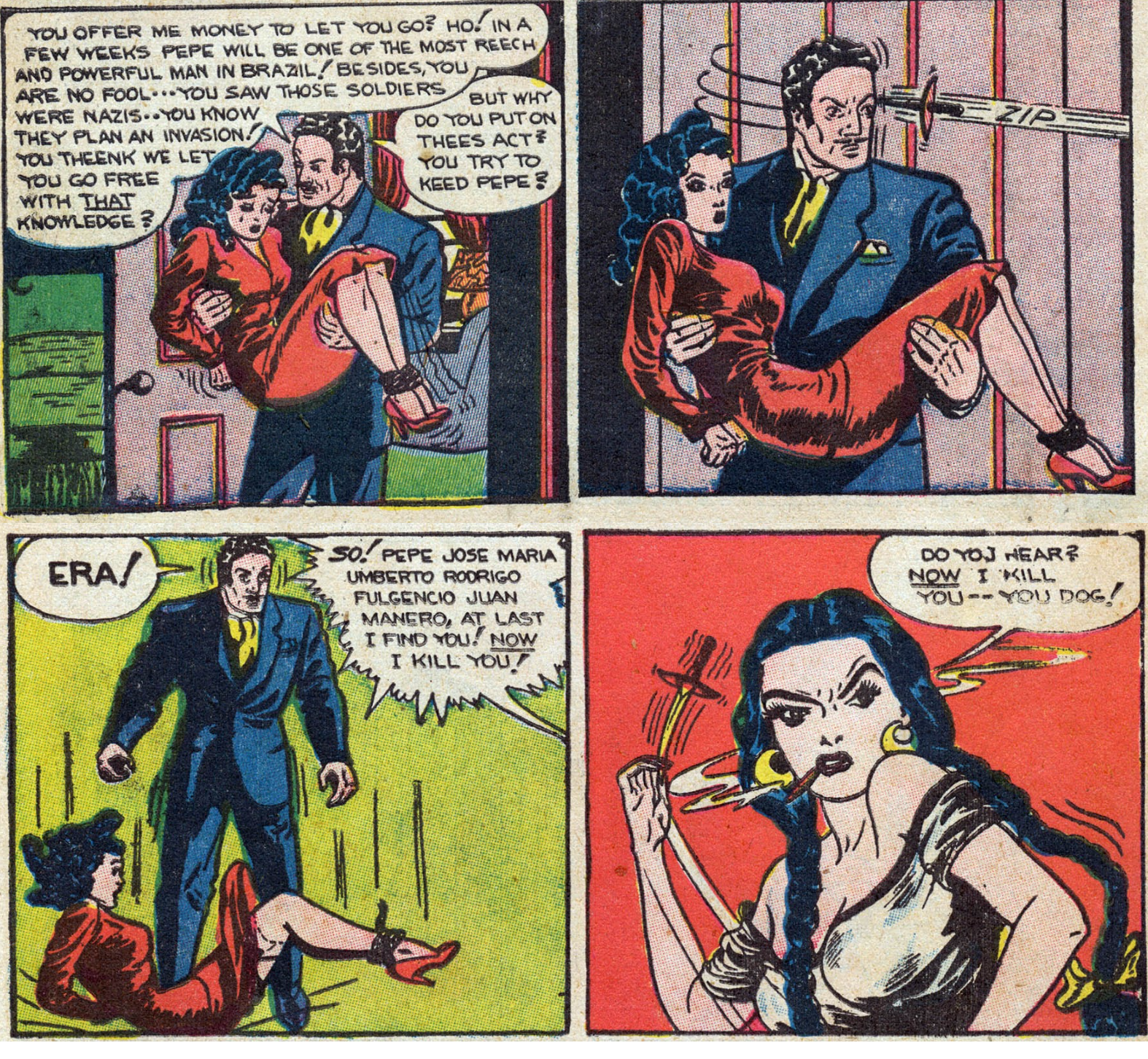
And, in one case, Miss Marla is freed by Era, the jealous rival of her captor, Manero the gangster, who is mashing on her, whom leaps out the window to avoid being knifed. But the rescuer things Miss Marla is a Nazi spy, so Marla ends up trussed like a turkey much the same as several pages earlier. But not to worry, Miss Marla will end up slapping around Era erelong.
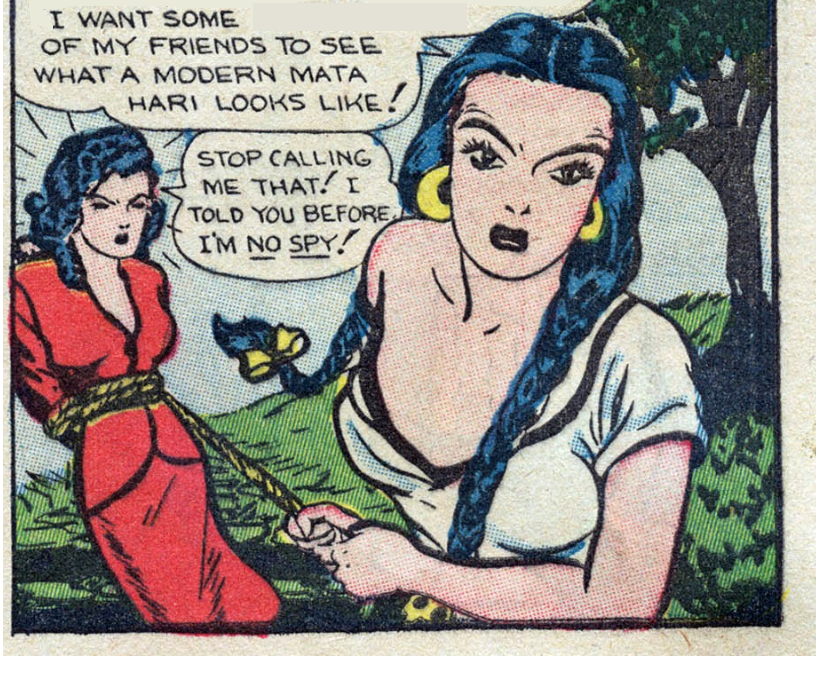
The one act Marla does of her own volition, is that she sees partisans about to lynch a Nazi (whom, unbeknownst to her, she accidently dismembered in a bomb misfiring when trying to save her cat), Marla thinks this is unlawful: the Nazi should be interred for the duration, not hanged. So she parts the hangman’s rope with one bullet-shot. The partisans conclude, not unreasonably, Miss Marla is a Nazi sympathizer.
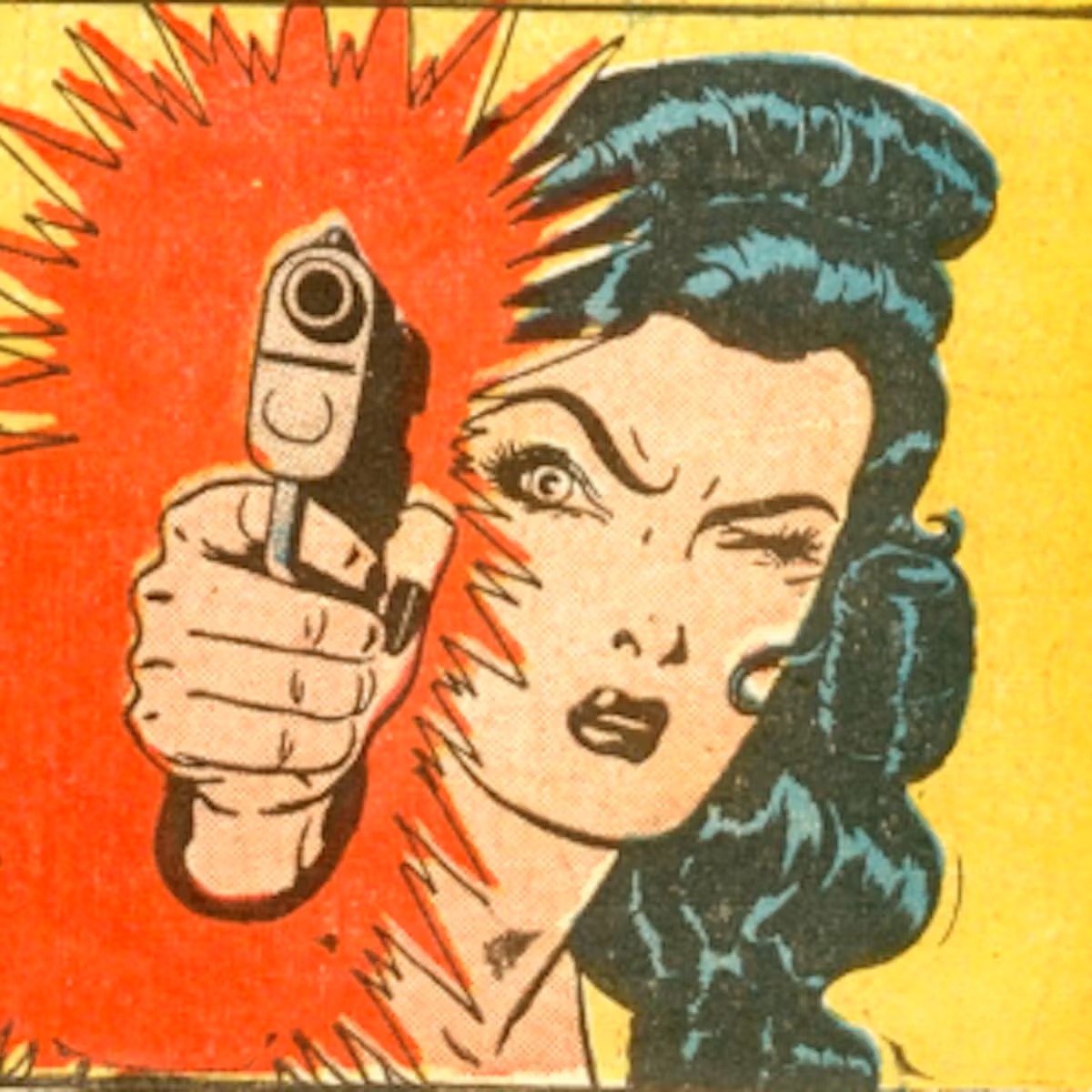
So the girl is a crack shot better than Annie Oakley, but this is the only time she fires a firearm. A female version of The Shadow, she is not.
None of the tropes associated with the superhero genre are present: instead, we see the tropes of a typical pulp tale involving spies and secret weapons, mistaken identities, missed chances to undo misunderstandings, and love triangles.
Lots of love triangles. More time is spent on the romantic angle than the spy story.
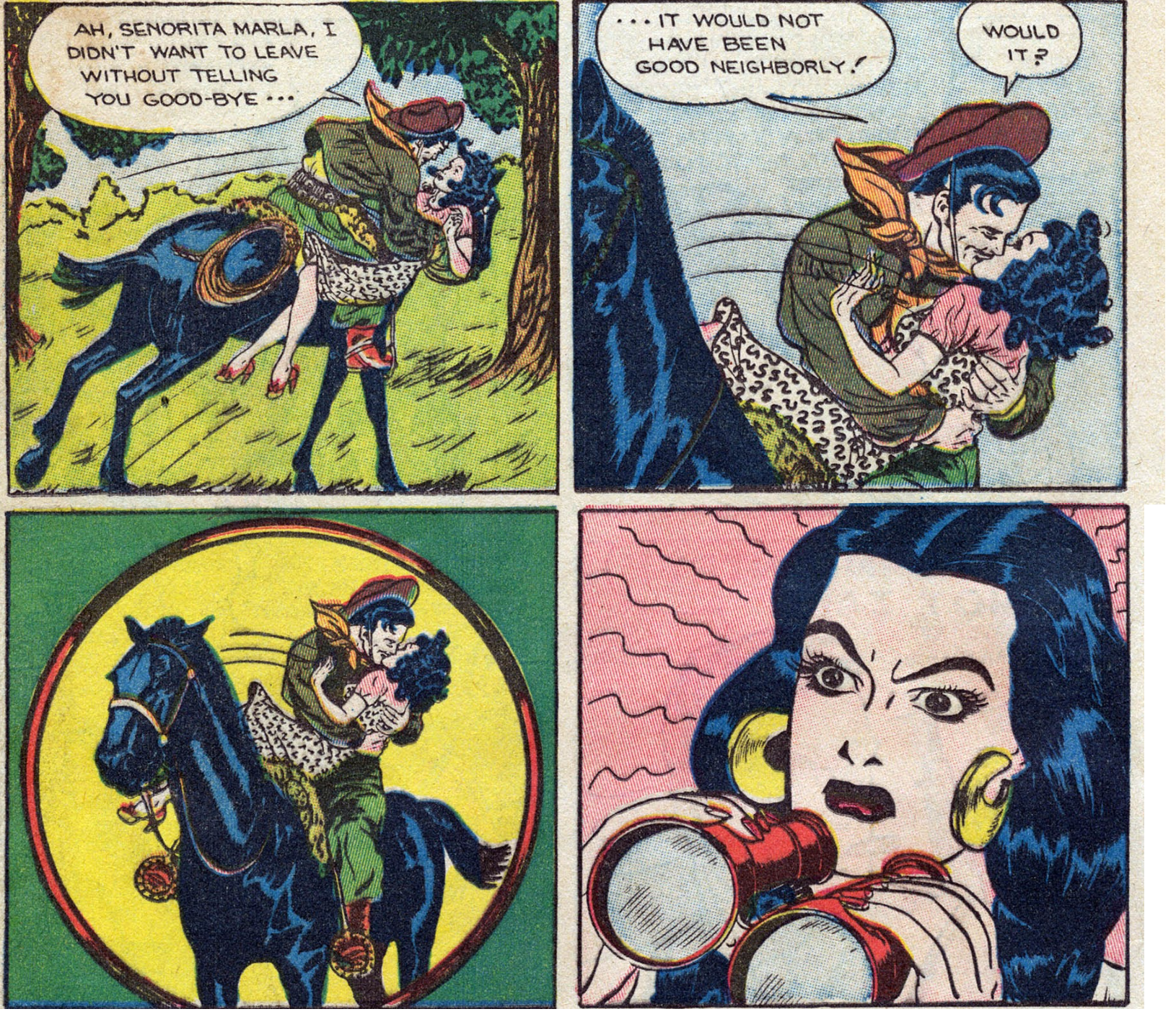
Much more.
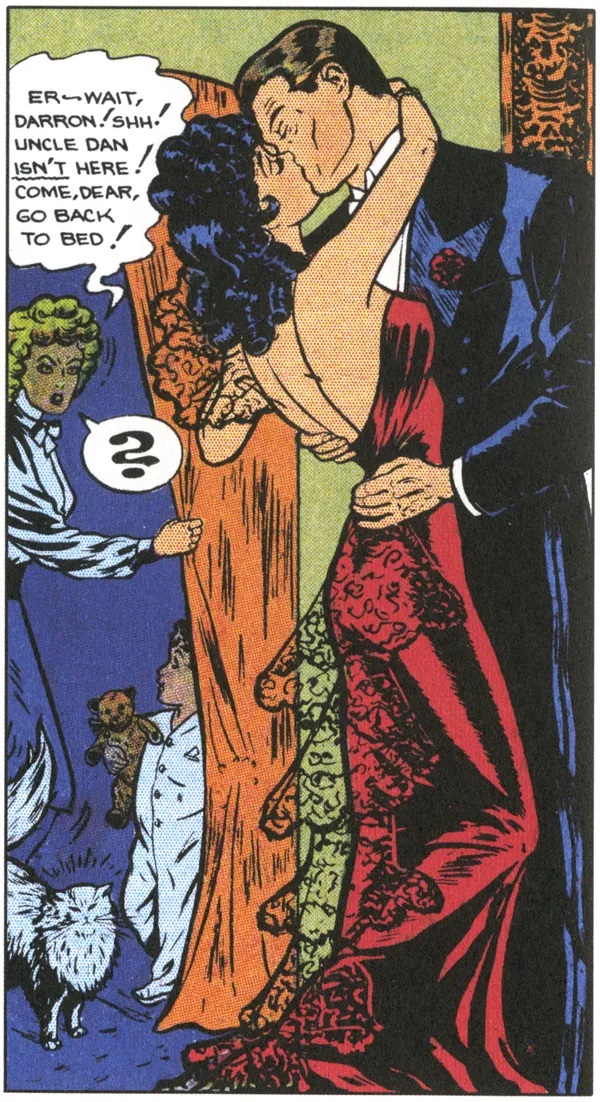
And not necessarily Marla’s romances. More pages are preoccupied with the torrid love affair and betrayals between Bruno and Erica, the two Nazis, and their mutual rivalry with Gruen of the Gestapo, his various murder attempts and coups, not to mention the other torrid love affair and betrayals between Erica and the mad doctor Diman Saraf, than are preoccupied with Miss Fury donning the black leopard-skin to do anything.
In fact, Miss Fury, the crimefightreess in the leopardskin, does not appear in nine tenth of her own story. After the opening episodes of the story, when the action moves to Rio, Miss Marla dons the black leopard skin robe precisely once more, this time for a sum total of seven panels.
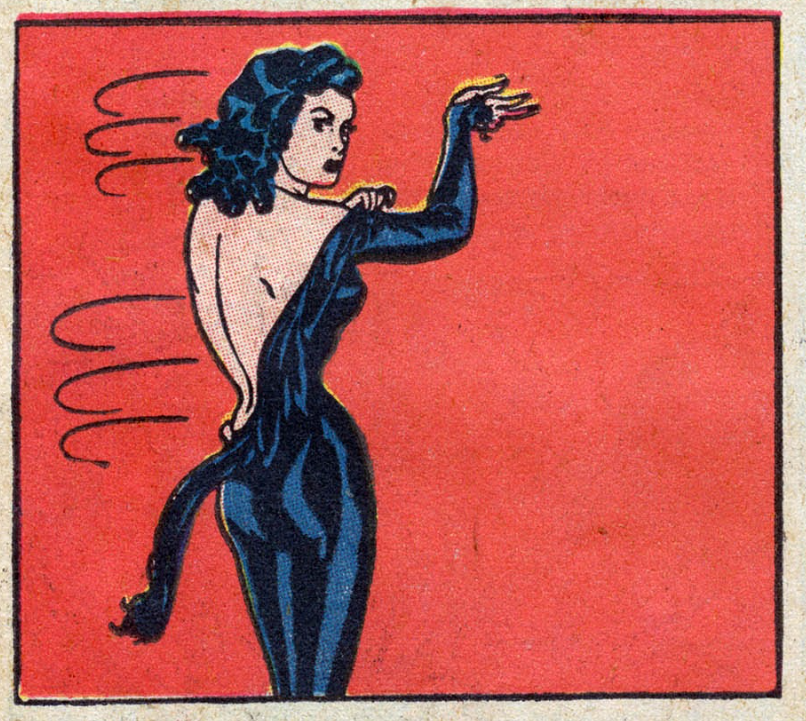
In costume, Miss Fury stalks through the jungle, gets caught yet again, this time by Amazonian tribesmen, meets Albino Jo, and convinces him to shoot pellets of metal-dissolving powder via blowgun against an armored Nazi column.
This powder, by a convoluted serious of mischances, came into Miss Fury’s possession in an earlier scene in issue one, which twelve-year-old readers of the Sunday strip would have mostly likely have forgotten by this time, as they read of these events circa age ten.
The Nazis tank column is being attacked in a narrow canyon by Era the bandit queen, and her allies, the gaucho, the gangster, and the flyboy, who are the main characters throughout this particular story arc, and who have the majority of the screentime, make the majority of plans, and carry them out.
This one scene is the only scene containing any element of science fiction or super-heroics, that is, not an element likely to be found in a mainstream story. The metal-dissolving powder is used up, and never seen again, so any implications of this fantastic technology as one might expect to be explored as in a science fiction story are not explored, nor its used as a superpower as one might expect it to be used in a superhero story.
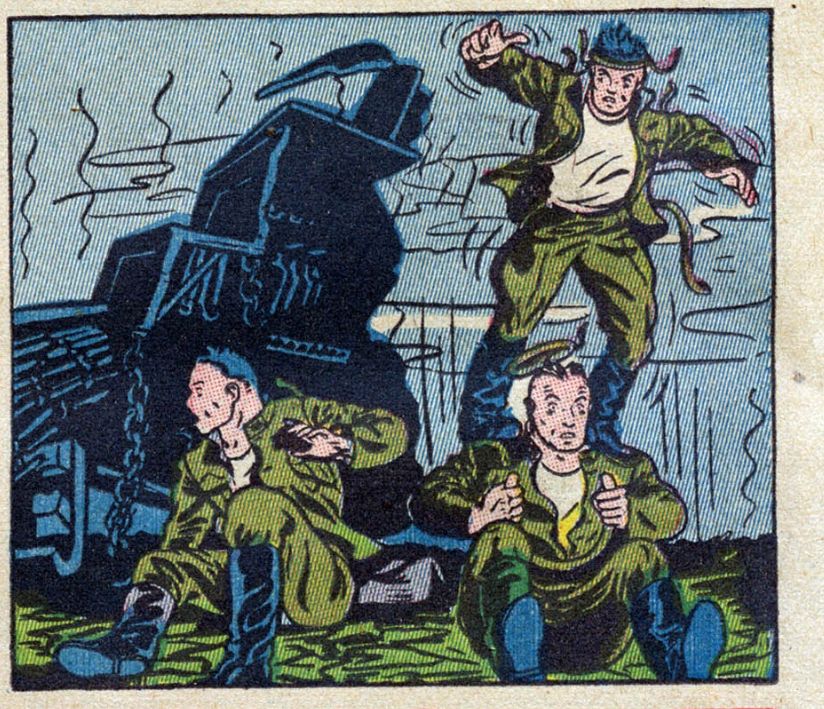
The writer is science-fictionally-minded enough to remember that the helmets, rifle barrels, and belt buckles of the anyone in the area would dissolve, but leave wooden stocks and leather hatbands dangling behind. The writer is romance-minded enough to have hot-blooded Latina Era of Brazil outraged and heartbroken when her huge gold earrings, given her by her inconstant lover Chico the Gaucho, dissolve away, when Era is brushed by the cloud.
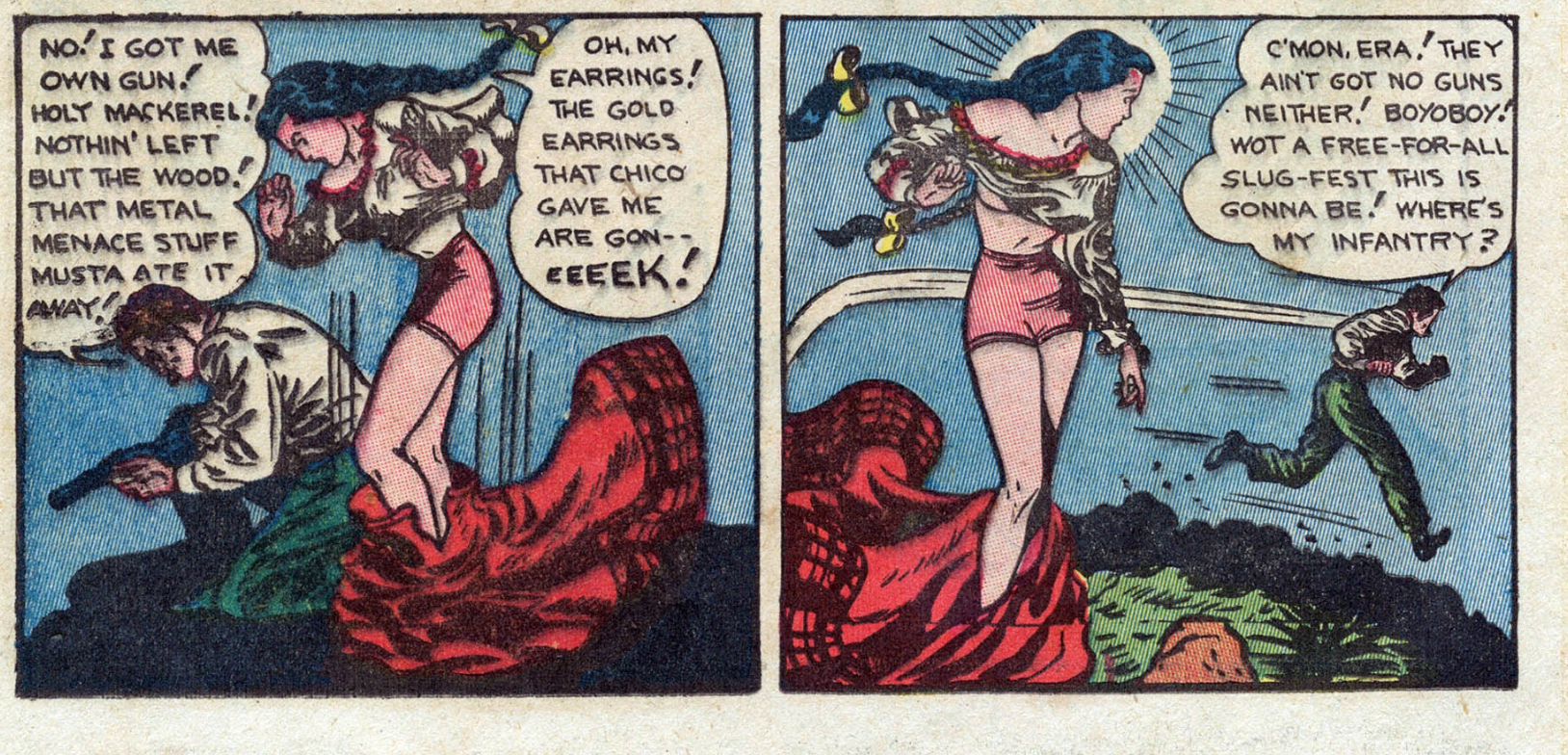
The writer is also cheesecake-minded enough to have Era the hot-blooded Brazilian babe lose her skirt when her skirt fastenings dissolve, displaying her shapely legs and hips to the reader.
Miss Fury, let it be noted, shoots not a single bullet during all this, nor lets fly an arrow, nor puffs a blowgun, nor whirls a bolo. She does nothing whatever superheroic or even heroic. She figures out a solution and gets a man to do it for her. (As a real girl, a feminine one, is wont to do).
She does not, let it be noted, leap from bridges onto moving cars, and kick armed gangsters into submission.
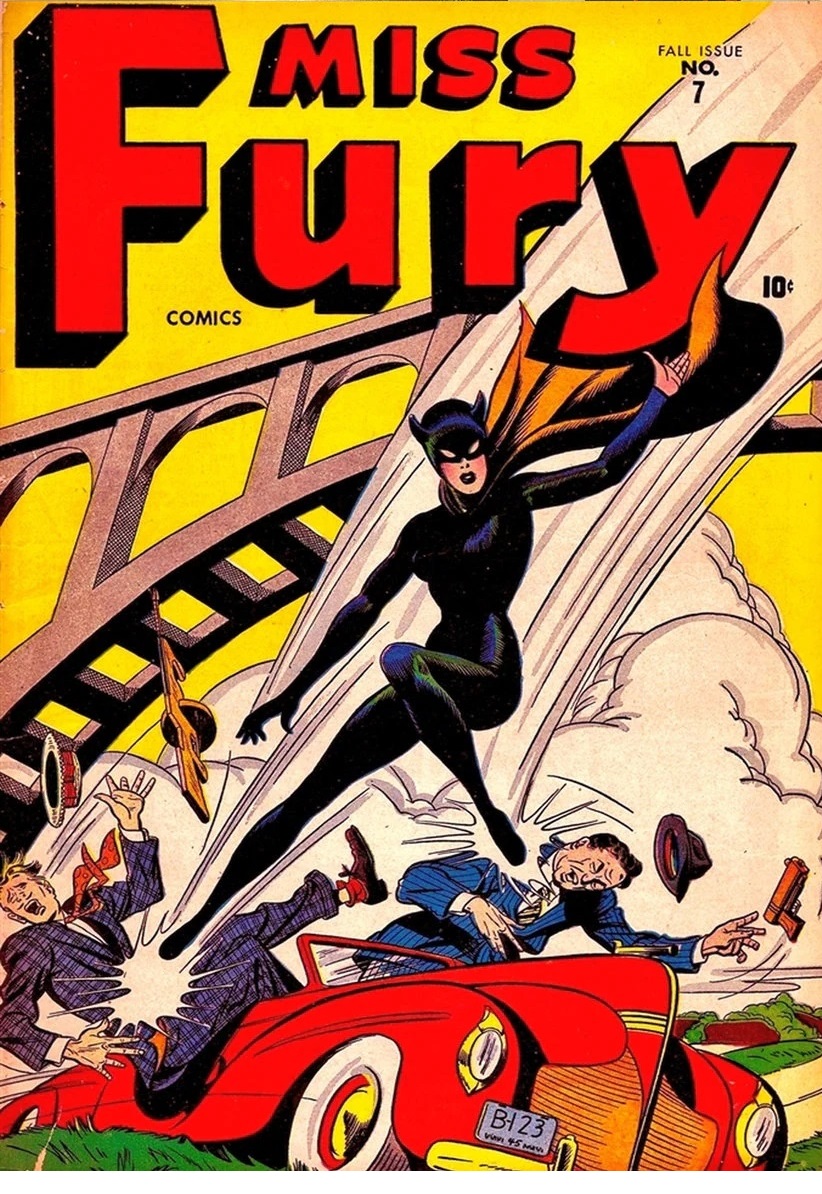
The battle scene is not without some charm and merit, as woefully ill-supplied irregulars, with nothing better than arrows and bolos, and a cache of dynamite, attack an armored column of Nazi stormtroopers.
The pacing of the story, from episode to episode is unusual for someone used to the conventions of Stan Lee style storytelling. To be frank, the tale reads more like a novel, with extensive swathes of dialog. The author, in her plot weaving, takes note of things like tactics and counter-tactics during combat planning scenes, and she never seems to forget any motives, goals, or plot points, even if she forgets to remind the reader of them. But this does not mean the plot is tight; rather this plot meanders down oxbows of side-streams until the candid reader cannot remember who the main character is meant to be.
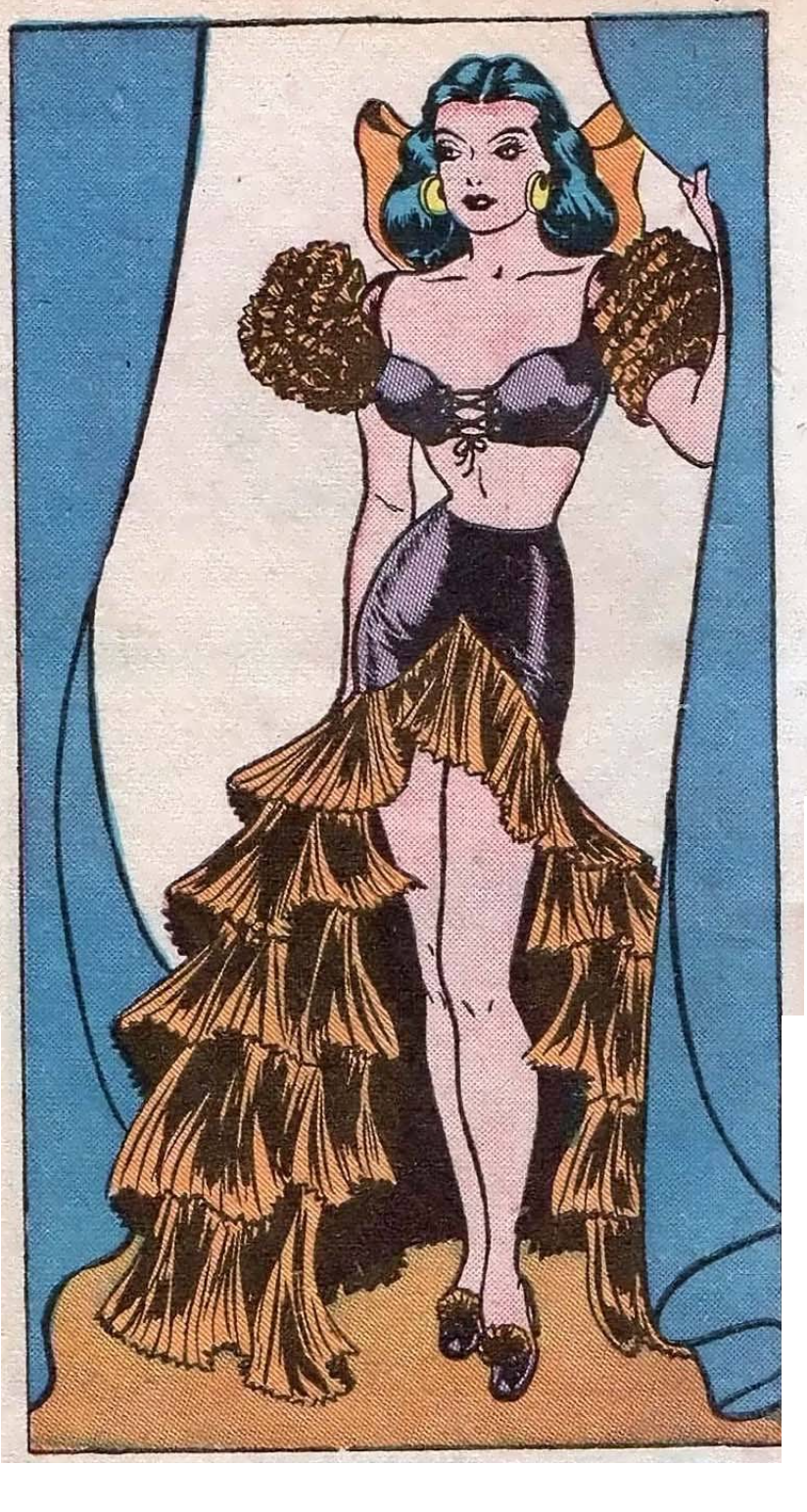
The author dwells lovingly on lady’s fashions, and all her female characters look glamorous, and all her men are bold and stalwart, but, as if often the case with male characters written by female authors, the menfolk tend to be slightly more emotional, dramatic, and unstoical than in real life.
To Tarpé Mills’ credit, all the characters have a complexity unusual in comic books: Any two characters in a room together with have established reasons both to like and to dislike each other. Melodrama there is aplenty. The villains are cruel and sadistic, as one expects of gangsters and Nazis in a lurid film noir style tale, but the Colonel Bruno, later General, is consistently portrayed as brave, honor-bound, disciplined, and tough as nails, not as a man without merit.
It is this villain, Bruno, not one of the heroes, who is left for dead on a battlefield, apparently pierced by countless spears, who, although himself wounded, carries a fellow soldier who died saving him on his shoulders many miles back to the camp of the men, including the treacherous Gestapo officer who tried to use the fog of war to arrange Bruno’s death.
The soldiers who thought him dead watch in awe, then in dread, at the commanding officer they failed to protect marches home with a corpse on his back of a man more valiant than they: he strips their medals and pins them on the corpse, whose grave he forces the dishonored soldiers to dig on with bare hands.
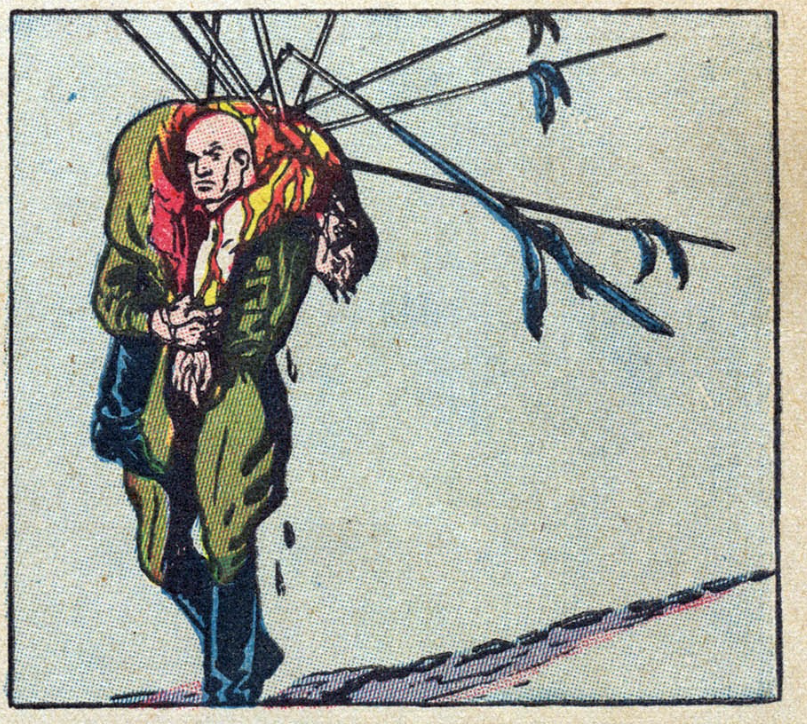
Unfortunately, since the panels were originally Sunday strips, every page and a half or so is a dramatic break, and the next panel, usually in laborious dialog, reminds the reader of what he just read. In a comic book format, this was a page ago rather than a week ago, and is nigh insufferable.
Also unfortunately, and for no clear reason, Tarpé Mills frequently has two characters in dialog describe something to each other both can clearly see, but no panel is drawn showing it. Crucial events are often mentioned in passing, after the fact, not shown.
The conventions followed are closer to those seen in Flash Gordon strips, or old-time Hawkman with its solid walls of text, or other Golden Age ventures. There are no sound effects, for example. No BANG nor POW nor THWACK. Dotted lines are used to show when a character is inspecting something closely, but the thing being inspected is rarely clearly drawn.

Men punch each other as frequently as one might expect in a hard-boiled detective novel or lurid melodrama, but only one fistfight, a boxing match, lasts more than one panel. This is long before the days when action was drawn in an exaggerated Jack Kirby fashion, so no one leans into a punch, nor shows any knockback when struck.
When Miss Marla gets into a fight, as should be clear by now, Tarpé Mills loses no chance to show off the girl’s legs and garterbelt.
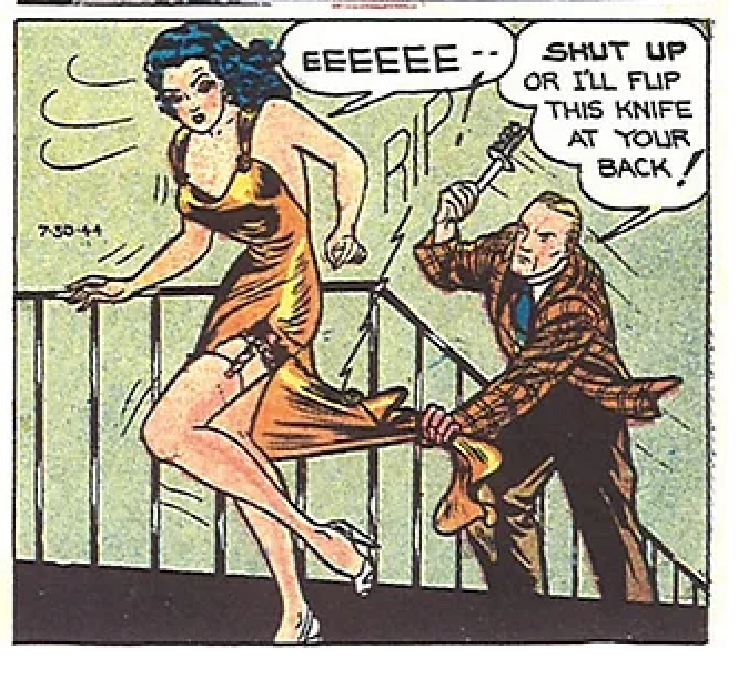
There are, unfortunately, no character arcs, but the author does remember who get maimed or blinded or branded. Wounds do not mysteriously vanish between panels. When Miss Fury sprains her arm, she is bedridden.
Of course, this is a romance, so while Miss Marla is bedridden, her fiancé who is waiting to propose to her thinks she is given him the cold shoulder, and when she flinches when he grabs her, he mistakes this for contempt, flies into a rage, and storms off to Rio. Her engagement ring will end up on the finger of that conniving wench, Baroness Elrica von Kampf, blonde Nazi babe.
Meanwhile, Detective Carey, who comes to visit her when she is sick (for she falls into a delirium as one does when wounded, or heartbroken, or both) speaks to her through a changing screen, since no gentleman would gaze upon a lady in her negligee, but she mistakes his voice, and extends her dainty hand around the edge of the screen, thinking he is another for whom her heart longs, and he warmly kisses it, unwilling to tell her who she is. Alas! The sorrow! Will he reveal his true feelings to her before it is too late?

Despite the cleverness of some of the plot-weaving, and the soap opera combined with crime drama with spy intrigue with war story, the whole thing is written in a cluttered, turgid fashion, awkwardly paced. The draftsmanship is good, but executed without much use of composition or perspective. Nearly every panel is a static flat mid-range shot, with an occasionally close-up on a face to show emotion. Hands are often awkwardly small, and the perspective on arms reaching toward the viewpoint is inexpert. The writing is often clever, but never exciting and far too wordy. None of the characters are particularly admirable, neither saintly nor heroic, albeit the soldiers and gauchos are always shown as brave and proud.
Miss Fury herself resents, and rightly so, the adventures intruding on her life, and considers the black leopard skin to be bad luck, which may in fact be the case: many overly dramatic and odd coincidences afflict and hound the poor debutante. She comes across as nosy rather than adventurous, but certainly she is full of moxie and spunk.
In sum, many of the plot elements were clever, and the characters likeable and well drawn, but the execution is poor, and I cannot recommend the strip. Miss Fury was forgotten for a reason.
Nonetheless, there is one other thing for which Miss Fury is remembered. Tarpé Mills was one of the first, perhaps the first, women who penned and illustrated a nationally syndicated comic strip.
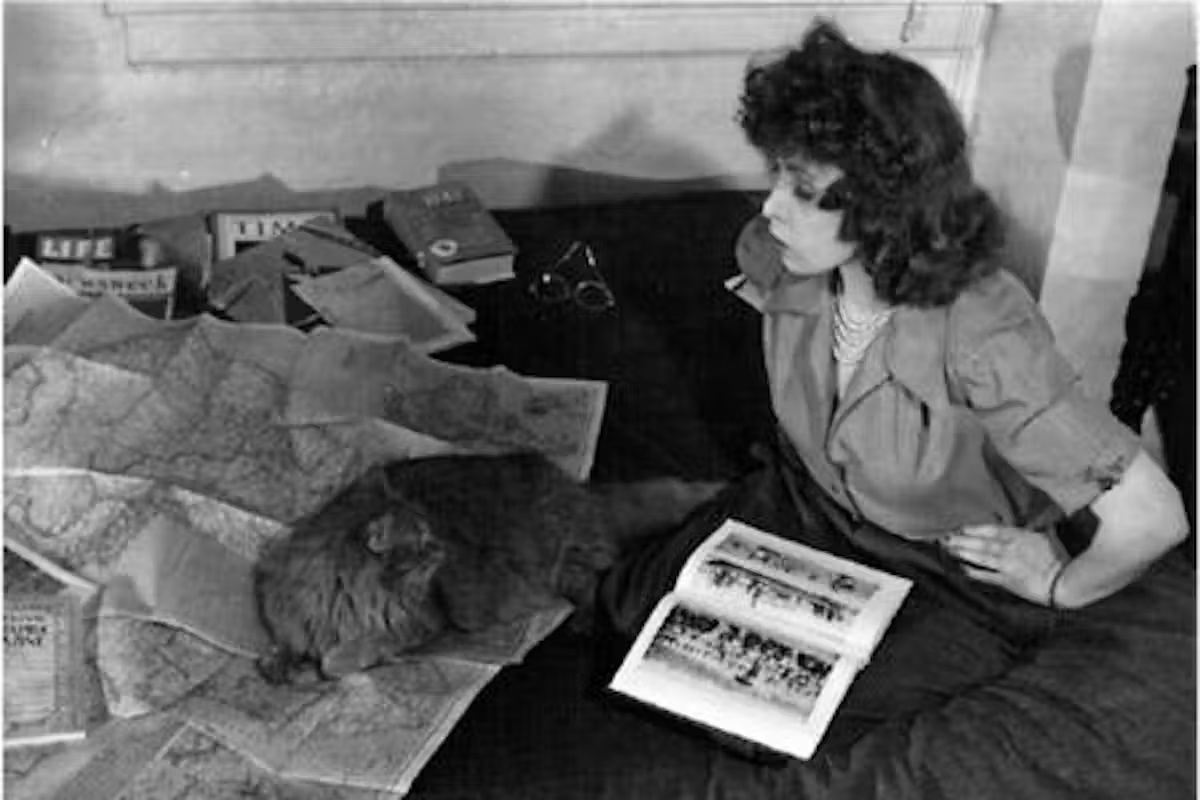
Tarpé Mills herself, or so it seems, has something of the look and demeanor of her own creation. She was certainly feisty enough to elbow here way into what had hitherto been an all-boys club.
According to a John Romita interview in Comic Book Artist #6, his now-iconic skintight 1970 costume redesign for Black Widow was based on Miss Fury. Rumors circle that Catwoman’s redesign in the 1980’s also was inspired from this (Catwoman herself in her first appearance merely wore a green dress).
Tarpé Mills earns credit as the first to present a cat-themed protagonist in the comics (she predates The Black Cat of Pocket Comics by six months, and Black Cat of Spiderman by three decades) even if, as seems to me, Miss Fury is neither superheroine nor adventuress. Nonetheless, Tarpé Mills merits being remembered as the mother of all the cat heroines and villainesses coming after.
But the trail does not stop there. Miss Fury may have inspired the other cat-themed characters in comics, but who inspired her?
For this review would not be complete without a mention made of her pet cat, who is faithfully represented as a character in the comic strip. Tarpé Mills own cat Peri Purr (as seen in the photo above) had been introduced in first panel of the first strip, has her own harrowing adventures when the Nazis try to use her as a living cat-bomb. Peri Purr was said to be an adopted mascot for the troops during the war.
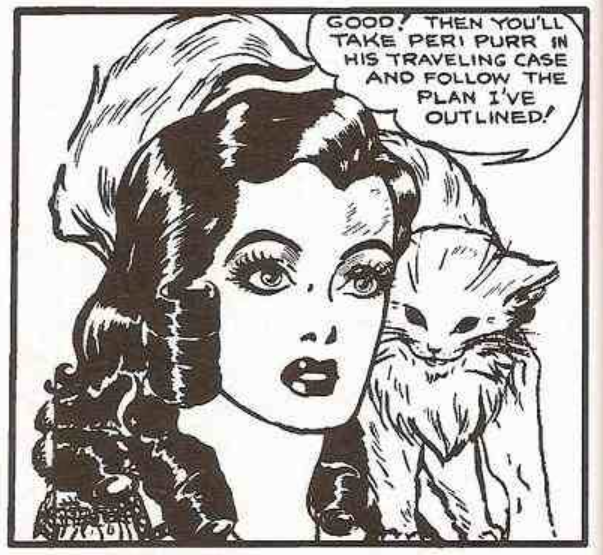
The character of Miss Fury was taken up again in recent publications by Dynamite Comics and others, and they have lurid cheesecake covers perhaps worthy of the spirit of Tarpé Mills, which seem to show a modern version who fits the mold of a catwomanly crimefightress moreso than the original. For reasons of my own, I would prefer to know no more about the modern revision of the character, since I have sincere doubts any modern pen could do her justice.
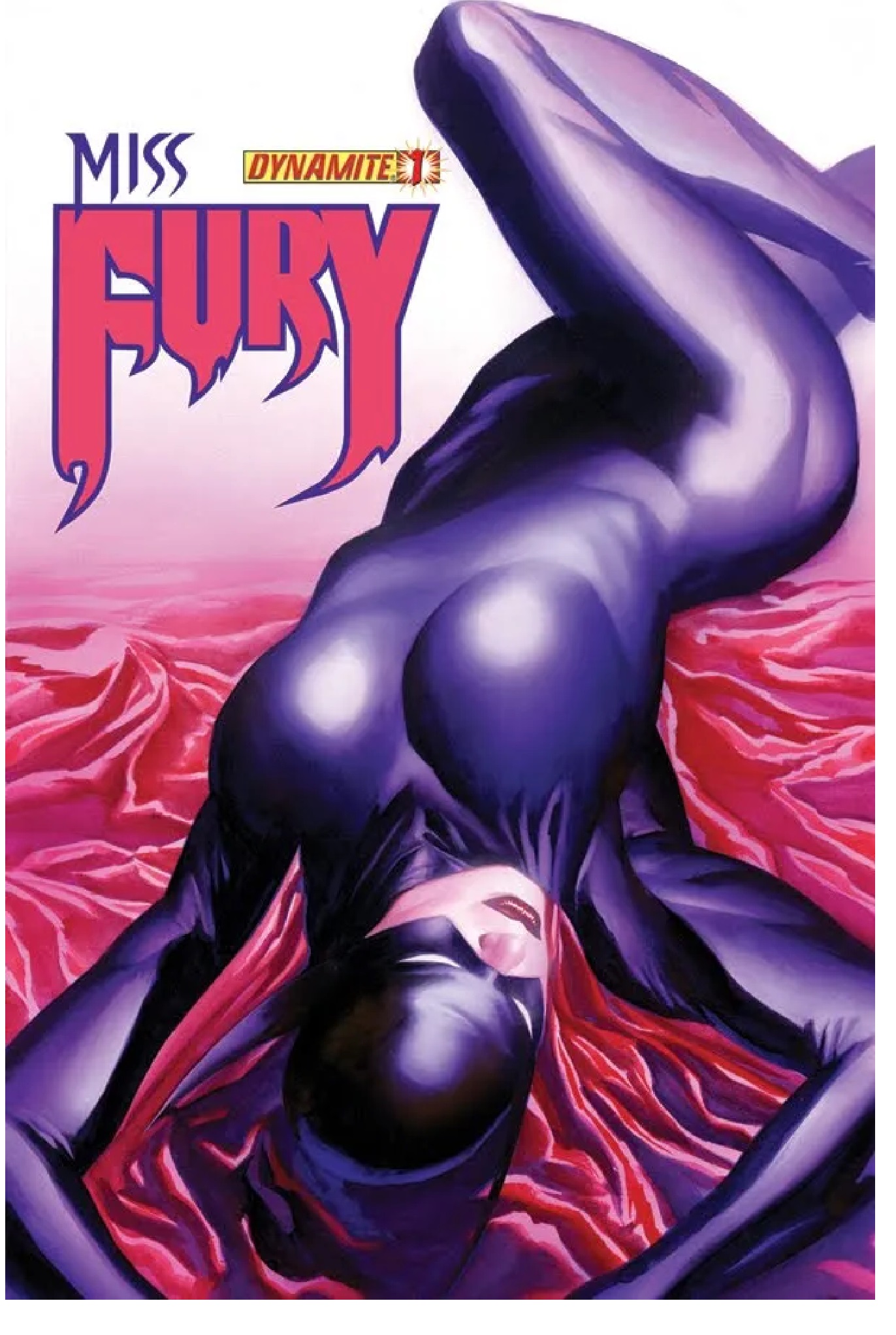
Miss Fury in the original is as feminine and feminine can be, and need no modern revision to masculinize her.
I submit that anyone who deems a girl who leaves claw marks when she slaps a masher, a ruffian, or a foreign spy, to be a proto-feminist shedding a stereotype simply misunderstands the character of the womenfolk of the war years.
The war-years women were what we now lack: strong female characters. Miss Fury can be counted as one of them, but not in the fashion modern fashions understand.
For one thing, she was glamorous.
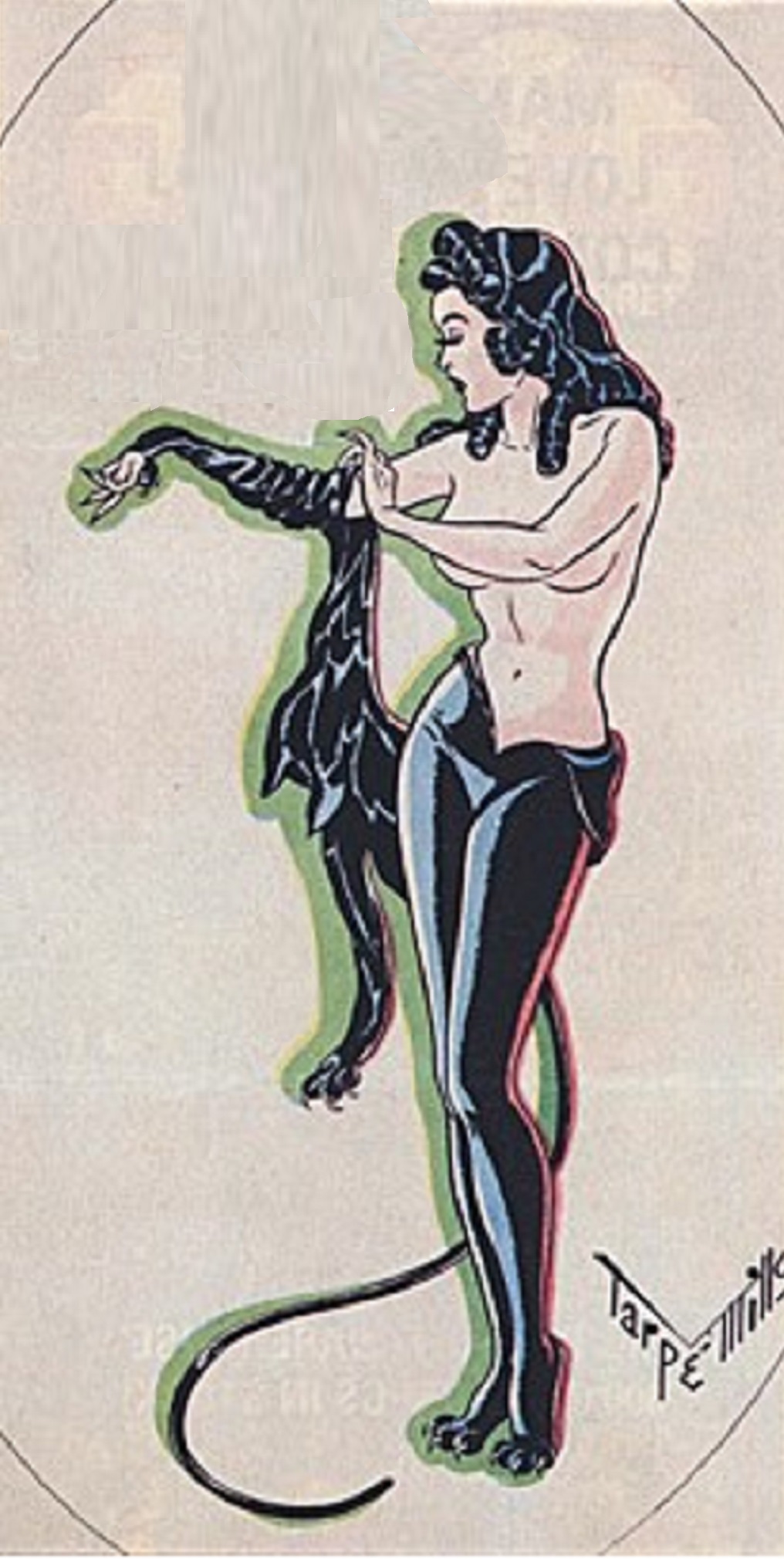
T
